CipherLab M0010 Terminal User Manual
CipherLab Co., Ltd. Terminal
Contents
- 1. Users manual 1
- 2. Users manual 2
Users manual 1
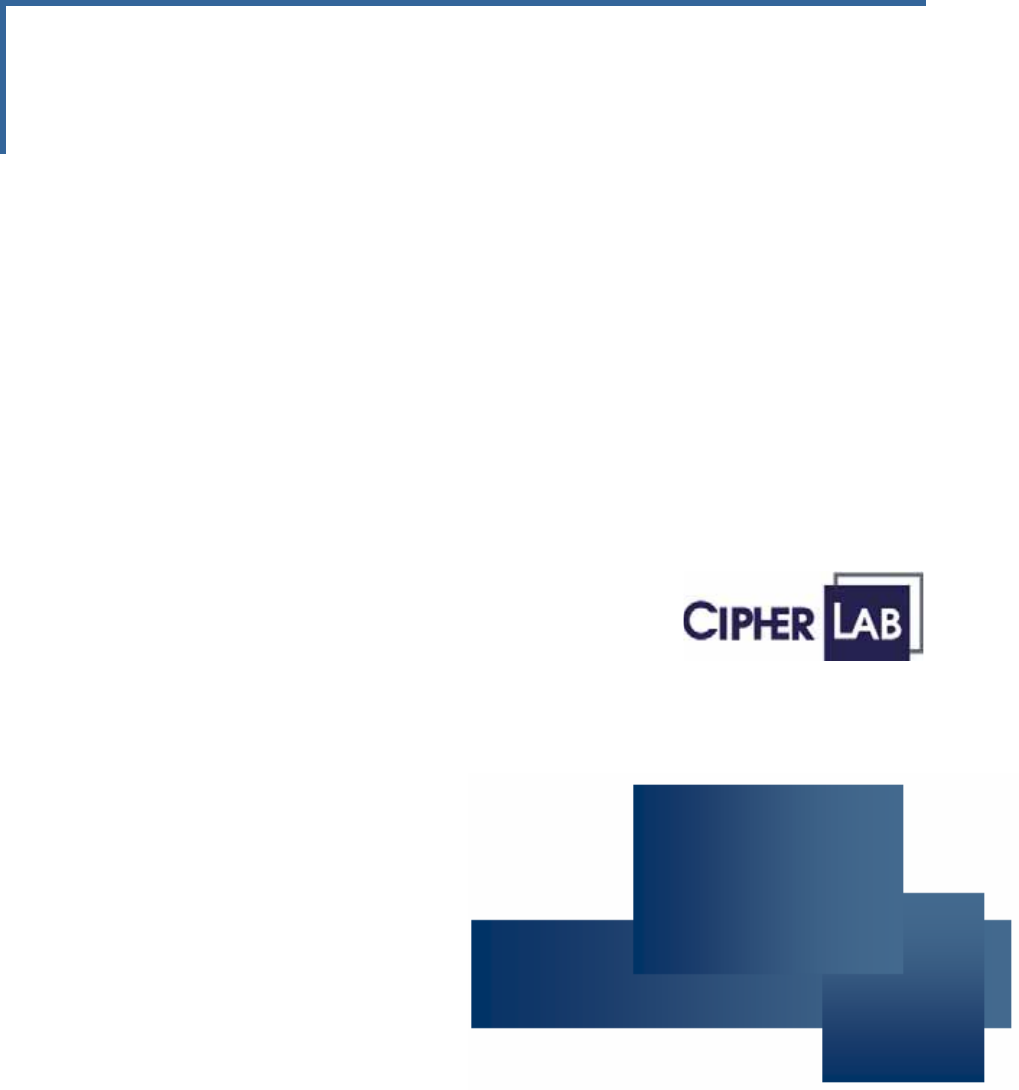
TERMINAL
Version 1.00
M
odel Name: M001
0

Copyright © 2007 CIPHERLAB CO., LTD.
All rights reserved
The software contains proprietary information of CIPHERLAB CO., LTD.; it is provided
under a license agreement containing restrictions on use and disclosure and is also
protected by copyright law. Reverse engineering of the software is prohibited.
Due to continued product development this information may change without notice.
The information and intellectual property contained herein is confidential between
CIPHERLAB and the client and remains the exclusive property of CIPHERLAB CO., LTD.
If you find any problems in the documentation, please report them to us in writing.
CIPHERLAB does not warrant that this document is error-free.
No part of this publication may be reproduced, stored in a retrieval system, or
transmitted in any form or by any means, electronic, mechanical, photocopying,
recording or otherwise without the prior written permission of CIPHERLAB CO., LTD.
For product consultancy and technical support, please contact your local sales
representative. Also, you may visit our web site for more information.
The CipherLab logo is a registered trademark of CIPHERLAB CO., LTD.
Microsoft, Windows, and the Windows logo are registered trademarks of Microsoft
Corporation in the United States and/or other countries.
Bluetooth is a trademark of Bluetooth SIG, Inc., U.S.A.
Other product names mentioned in this manual may be trademarks or registered
trademarks of their respective companies and are hereby acknowledged.
The editorial use of these names is for identification as well as to the benefit of the
owners, with no intention of infringement.
CIPHERLAB CO., LTD.
Website: http://www.cipherlab.com

FCC REGULATIONS
This equipment has been tested and found to comply with the limits for a Class B
digital device, pursuant to Part 15 of the FCC Rules. These limits are designed to
provide reasonable protection against harmful interference in a residential
installation. This equipment generates, uses and can radiate radio frequency energy
and, if not installed and used in accordance with the instructions, may cause harmful
interference to radio communications. However, there is no guarantee that
interference will not occur in a particular installation. If this equipment does cause
harmful interference to radio or television reception, which can be determined by
turning the equipment off and on, the user is encouraged to try to correct the
interference by one or more of the following measures:
Reorient or relocate the receiving antenna.
Increase the separation between the equipment and receiver.
Connect the equipment into an outlet on a circuit different from that to which
the receiver is connected.
Consult the dealer or an experienced radio/TV technician for help.
SAFETY PRECAUTIONS
RISK OF EXPLOSION IF BATTERY IS REPLACED BY AN INCORRECT TYPE
DISPOSE OF USED BATTERIES ACCORDING TO THE INSTRUCTIONS
The use of any batteries or charging devices, which are not originally sold or
manufactured by CipherLab, will void your warranty and may cause damage to
human body or the product itself.
The charging and communication cradle uses an AC power adaptor. A socket
outlet shall be installed near the equipment and shall be easily accessible. The
power adaptor should comply with L.P.S test. Make sure there is stable power
supply for the mobile computer or its peripherals to operate properly.
DO NOT disassemble, incinerate or short circuit the battery pack.
DO NOT expose the mobile computer or the battery pack to any flammable
sources.
Under no circumstances, internal components are self-serviceable.
Per FDA and IEC standards, the scan engines described in this manual are not
given a laser classification. However, the following precautions should be
observed:
CAUTION
IMPORTANT NOTICES

This laser component emits FDA / IEC Class 2 laser light at the exit port. Do not
stare into beam.
CARE & MAINTENANCE
This mobile computer is intended for industrial use. The mobile computer is rated
IP 64, however, it may do damage to the mobile computer when being exposed
to extreme temperatures or soaked wet.
When the body of the mobile computer gets dirty, use a clean and wet cloth to
wipe off the dust. DO NOT use/mix any bleach or cleaner. Always keep the LCD
dry.
For a liquid crystal display (LCD) or touch screen, use a clean, non-abrasive,
lint-free cloth to wipe dust off the screen. DO NOT use any pointed or sharp
object to move against the surface.
Battery disposal - For green-environment issue, it is important that batteries should
be recycled in a proper way.
If you want to put away the mobile computer for a period of time, download the
collected data to a host computer, and then take out the battery pack. Store
the mobile computer and battery pack separately.
When the mobile computer resumes its work, the main and backup batteries will
take a certain time to become fully charged.
If you shall find the mobile computer malfunctioning, write down the specific
scenario and consult your local sales representative.
FCC REGULATIONS:
This device complies with part 15 of the FCC Rules. Operation is subject to the following
two conditions: (1) This device may not cause harmful interference, and
(2) this device must accept any interference received, including interference that may
cause undesired operation.
You are cautioned that changes or modifications not expressly approved by the party
responsible for compliance could void your authority to operate the equipment.
This equipment complies with FCC radiation exposure limits set forth for an uncontrolled
environment. This equipment should be installed and operated with minimum distance
20cm between the radiator & your body.
It only operated in hand-held used. If you only transfer data to Host by WLAN, please
keep the minimum distance 20cm between machine & your body.

VERSION DATE NOTES
1.00 Aug. 10,
2007
Initial release
RELEASE NOTES

CONTENTS
IMPORTANT NOTICES ..............................................................................................................3
FCC Regulations.....................................................................................................................3
Safety Precautions .................................................................................................................3
Care & Maintenance............................................................................................................4
RELEASE NOTES........................................................................................................................5
INTRODUCTION .......................................................................................................................1
Getting Familiarized with 9400.............................................................................................2
Installing the Hand Strap..................................................................................................3
Installing the Pistol Grip.....................................................................................................4
Dimensions ..............................................................................................................................6
Features ...................................................................................................................................6
Inside the Package................................................................................................................8
Accessories .............................................................................................................................8
USING THE TERMINAL ..............................................................................................................9
1.1 Battery................................................................................................................................9
1.1.1 Inserting the Battery...............................................................................................10
1.1.2 Charging the Battery ............................................................................................12
1.1.3 Understanding the Battery Icons.........................................................................13
1.1.4 Power Management.............................................................................................13
1.2 Memory ...........................................................................................................................15
1.2.1 Caution of Data Loss.............................................................................................15
1.2.2 Checking the Storage Space..............................................................................15
1.2.3 Inserting the miniSD Card .....................................................................................17
1.3 Keypad ............................................................................................................................18
1.3.1 Using the Keypad...................................................................................................19
1.3.2 Alpha Key................................................................................................................19
1.3.3 Function Key ...........................................................................................................20
1.3.4 Programmable Keys ..............................................................................................21
1.4 Touch Screen..................................................................................................................21
1.4.1 Adjusting the Backlight .........................................................................................22
1.4.2 Re-calibrating the Screen ....................................................................................24
1.5 Notifications ....................................................................................................................24
1.5.1 Status LED ................................................................................................................24
1.5.2 Audio........................................................................................................................25
1.5.3 Vibrator ....................................................................................................................26
1.6 Data Capture .................................................................................................................26
1.6.1 Barcode & RFID Reader........................................................................................26
1.6.2 Digital Camera.......................................................................................................26

9400 Mobile Computer Reference Manual
1.7 Communications ...........................................................................................................26
1.7.1 Using the Cradle ....................................................................................................26
1.7.2 Inserting the SIM Card ...........................................................................................28
1.7.3 Turn off the Wireless Networks..............................................................................29
1.7.4 Using the Headset..................................................................................................29
LEARNING WINDOWS CE BASICS ........................................................................................31
2.1 Getting Started ..............................................................................................................31
2.1.1 Desktop....................................................................................................................33
2.1.2 Taskbar.....................................................................................................................34
2.1.3 Start Menu...............................................................................................................36
2.1.4 Input Methods ........................................................................................................37
2.2 Finding out the Capabilities of Your Mobile Computer ..........................................38
2.3 Using ActiveSync............................................................................................................40
2.3.1 Synchronization with Your Computer.................................................................40
2.3.2 Add/Remove Programs........................................................................................41
2.3.3 Backup/Restore......................................................................................................43
2.4 Managing Programs .....................................................................................................43
2.4.1 Quick Launch a Program .....................................................................................43
2.4.2 Create a Folder......................................................................................................47
2.4.3 Switch among Programs and Desktop ..............................................................47
2.4.4 Exit a Program ........................................................................................................47
2.5 System Reset & Auto Run .............................................................................................48
2.5.1 Software Reset (Warm Reboot) ..........................................................................48
2.5.2 Hardware Reset (Cold Reboot) ..........................................................................48
2.5.3 Auto Run..................................................................................................................49
2.6 Updating OS Image ......................................................................................................49
PERSONALIZING THE TERMINAL............................................................................................53
3.1 Changing System Settings............................................................................................53
3.2 Changing Connection Settings...................................................................................56
3.2.1 USB Connection .....................................................................................................58
3.2.3 WLAN........................................................................................................................59
3.2.4 BTPAN .......................................................................................................................63
USING APPLICATIONS...........................................................................................................65
4.1 Wireless Power Manager ..............................................................................................66
4.2 Bluetooth Manager .......................................................................................................67
4.2.1 Bluetooth Profiles Supported................................................................................67
4.2.2 Bluetooth Toolbar...................................................................................................68
4.2.3 Starting Bluetooth Services...................................................................................72
4.2.4 Discovering Bluetooth Devices............................................................................73
4.2.5 Pairing ......................................................................................................................74
4.2.6 Connecting.............................................................................................................75
4.3 Reader Configuration Utility.........................................................................................80
4.3.1 Barcode Reader Settings .....................................................................................81
Terminal Reference Manual
4.3.2 RFID Reader Settings .............................................................................................81
4.3.3 Data Output ...........................................................................................................82
4.3.4 Beeper / Vibrator ...................................................................................................84
4.3.5 Symbology Settings ...............................................................................................84
4.4 Inbox ................................................................................................................................84
4.4.1 Creating an E-mail Box .........................................................................................85
4.4.2 Synchronizing Inbox...............................................................................................88
4.5 Backup Utility ..................................................................................................................89
4.5.1 Managing the Registry..........................................................................................90
4.5.2 Getting Ready for Backing up Files ....................................................................92
4.5.3 Backing up Files......................................................................................................93
4.5.4 Using Backups for Restore ....................................................................................94
4.6 Button Assignment Utility...............................................................................................97
SPECIFICATIONS..................................................................................................................101
Platform, Processor & Memory ........................................................................................101
Communications & Data Capture .................................................................................101
Electrical Characteristics ..................................................................................................102
Physical Characteristics ....................................................................................................102
Environmental Characteristics.........................................................................................103
Programming Support .......................................................................................................103
Accessories ..........................................................................................
SCAN ENGINE SETTINGS .......................................................................
Symbologies Supported.....................................................................
RFID Tags Supported...........................................................................
CCD/LASER SCAN ENGINE ...................................................................
Reader Settings Table ........................................................................
Symbology Settings Table..................................................................
2D SCAN ENGINE...................................................................................
Reader Settings Table ........................................................................
Symbology Settings Table..................................................................

1
The terminal Series, running Windows CE 5.0 in palm size, is our first product line of
rugged PDA-style Mobile Computer. Light-weight, streamlined and ergonomic, it
adds even more powerful and handy tools to delivering the flexibility in
customization.
Specifically designed to work as an industrial PDA, the terminal Series provides rich
options of data collection, voice and data communications, long-lasting working
hours, and so on. Its large color transflective TFT display guarantees ease in reading in
all lighting conditions. Integrated with Bluetooth and 802.11b/g technologies.
This manual serves to guide you through how to install, configure, and operate the
mobile computer. The Care & Maintenance section is specifically prepared for those
who are in charge of taking care of the mobile computer.
We recommend you to keep one copy of the manual at hand for quick reference or
maintenance purposes. To avoid any improper disposal or operation, please read
the manual thoroughly before use.
Thank you for choosing CipherLab products!
INTRODUCTION
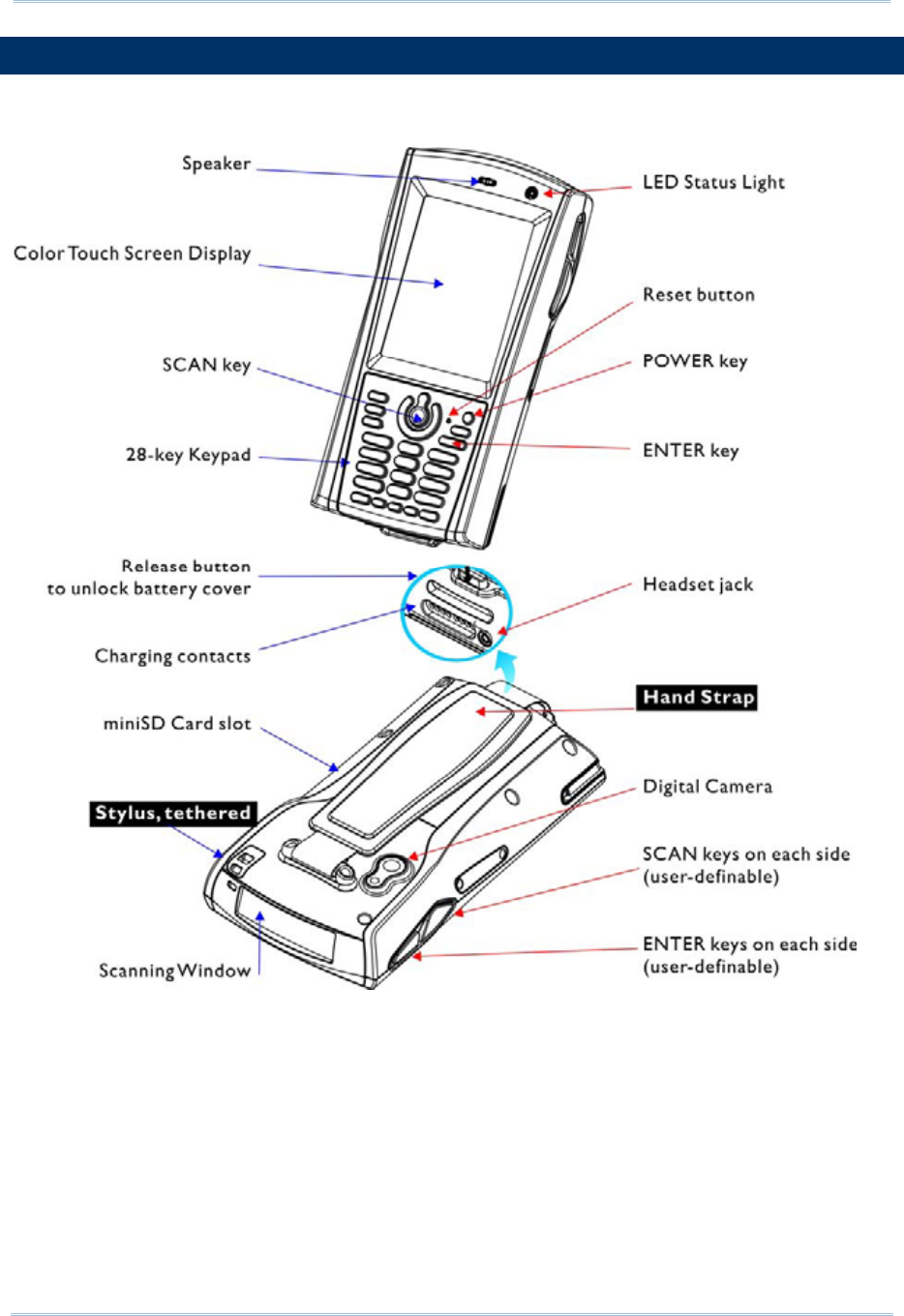
2
Terminal Reference Manual
GETTING FAMILIARIZED WITH TERMINAL
Figure 1: Front / Back
View
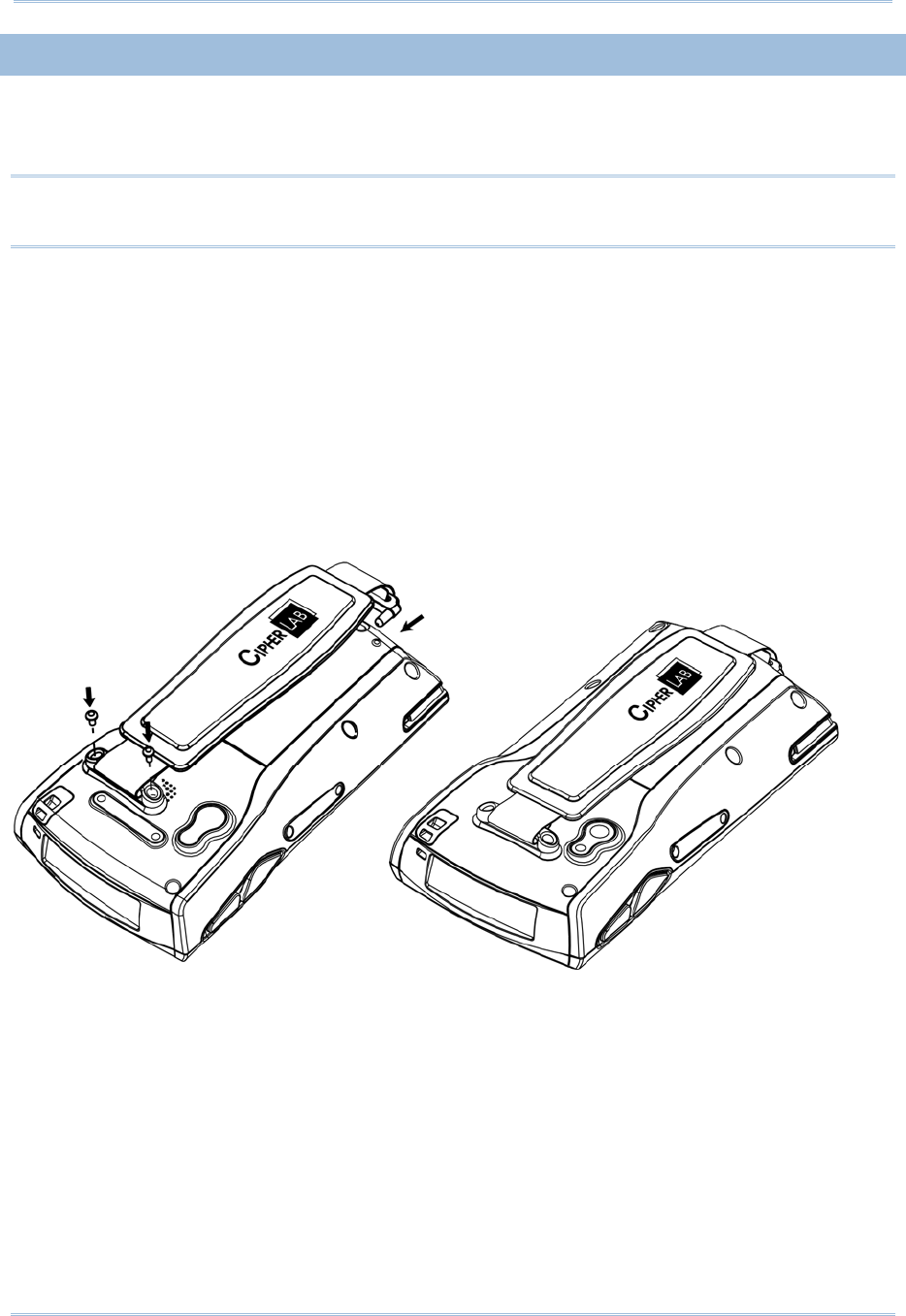
3
INSTALLING THE HAND STRAP
The hand strap is ideal for one-handed operation, which requires safe and
convenient hold of the mobile computer.
Warning: Always make sure the hand strap is well hooked and screwed to the
back of the mobile computer before use.
When the hand strap is desired, install it to the mobile computer by following these
steps:
1) Place the mobile computer face down on a flat and clean surface.
2) Screw one end of the hand strap to the back of the mobile computer.
3) Insert and hook the other end of the hand strap to the bottom of the mobile
computer.
4) Make sure the hand strap is securely attached to the mobile computer.
5) Adjust the length of the hand strap to suit your handbreadth.
Figure 2: Installing the
Hand Strap

4
Terminal Reference Manual
INSTALLING THE PISTOL GRIP
This contoured pistol grip enables intuitive trigger-and-scan operation, which is very
helpful in scan intensive applications.
When a pistol grip is necessary, install it to the mobile computer by following these
steps:
1) Press for the mobile computer to enter suspend mode.
2) Place the mobile computer face down on a flat and clean surface.
3) Remove the hand strap as well as the side plates as shown below.
4) Connect the power connector from the pistol grip to the receptacle on the
mobile computer.
5) Screw the pistol grip to the back of the mobile computer.
6) Make sure all screws are tightened up.
7) Turn on the mobile computer to test the trigger.
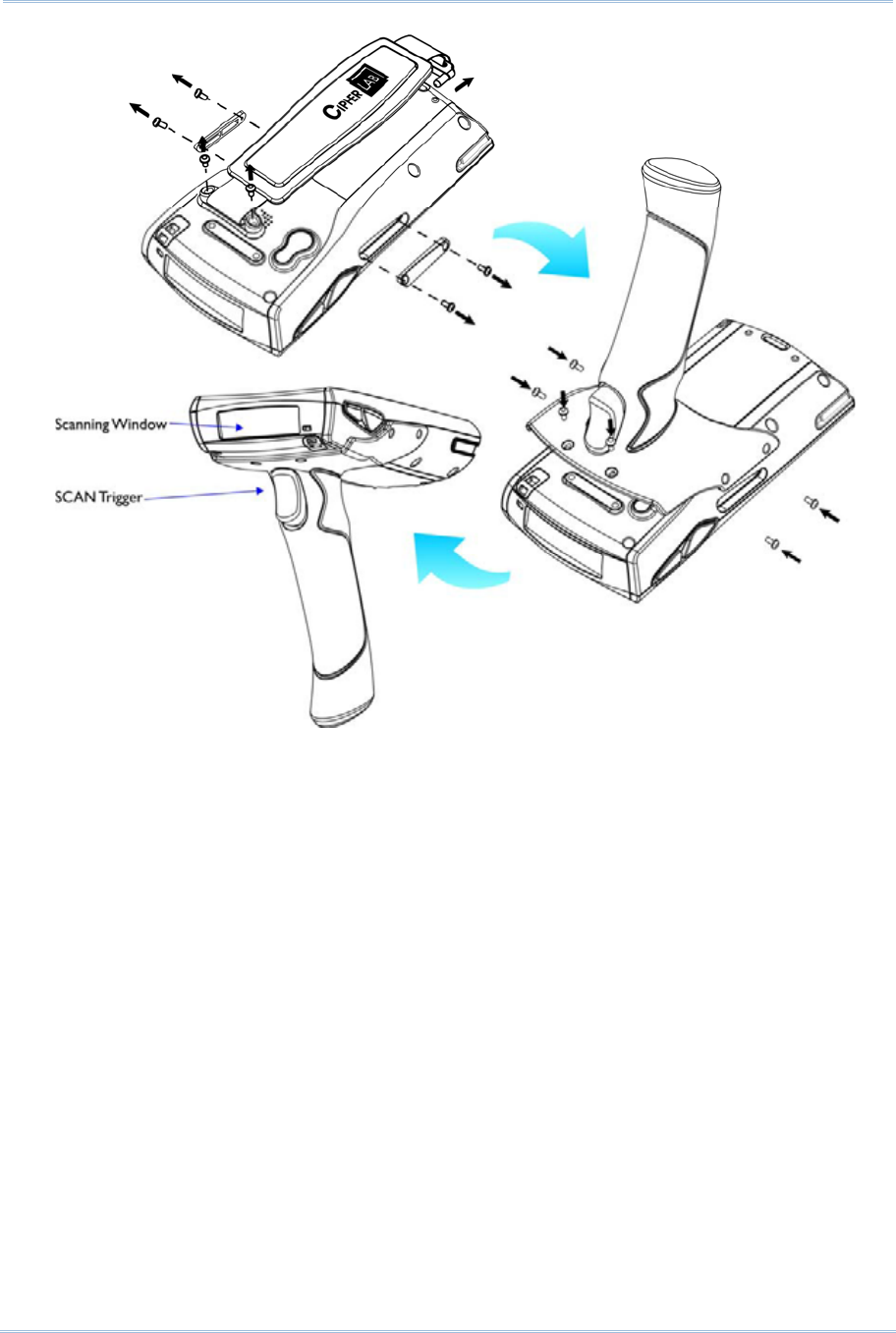
5
Figure 3: Installing the
Pistol Grip
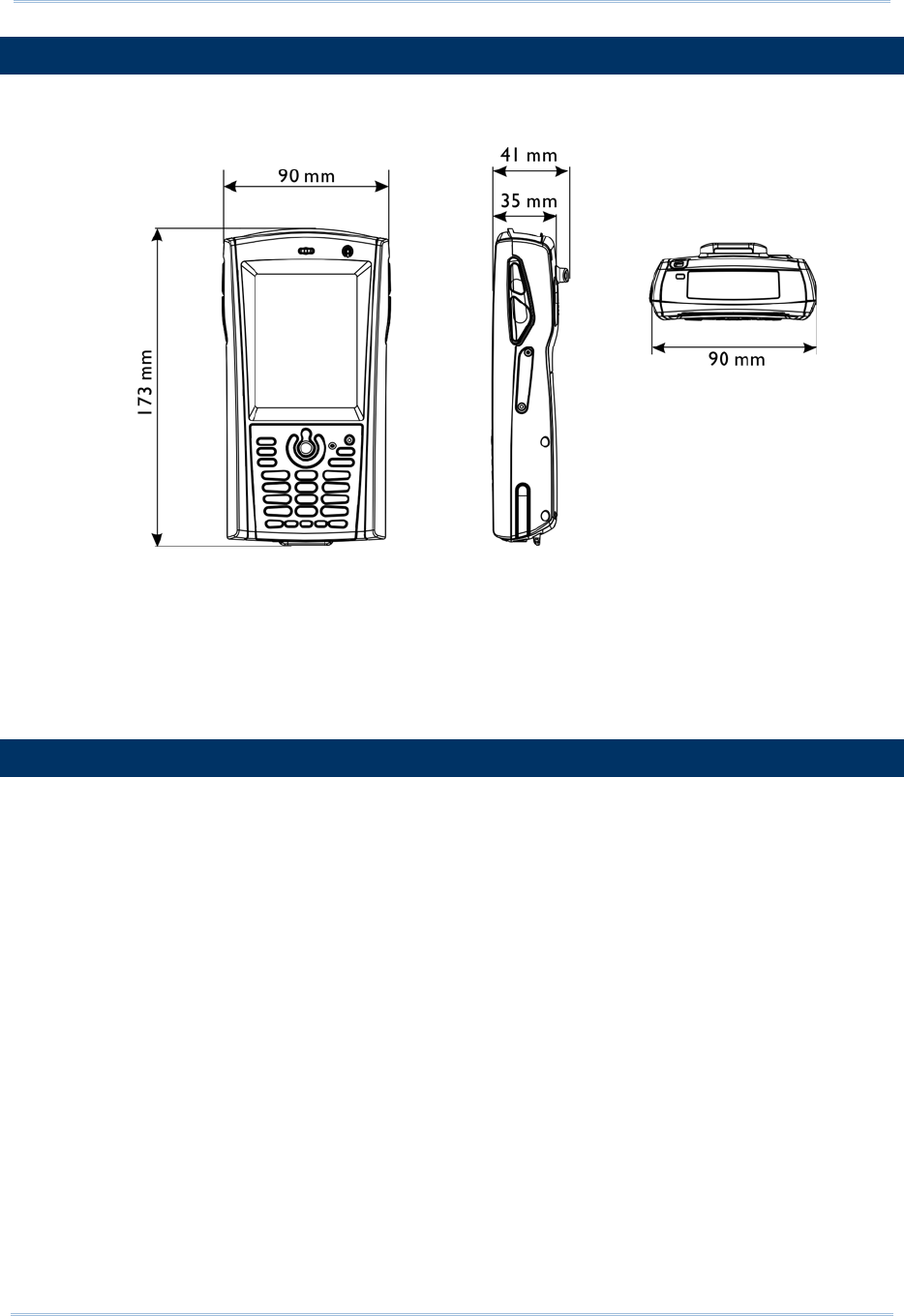
6
Terminal Reference Manual
DIMENSIONS
FEATURES
Ergonomic design - ruggedized yet streamlined, with hand strap for secure hold.
Built tough to survive drop test and sealed against moisture/dust to industrial
standard IP 64.
Microsoft Windows CE 5.0 operating system, 520 MHz Intel PXA270 processor
128 MB non-volatile NAND flash memory to store OS and software programs
(part of the free space is used as a storage card called DiskOnChip)
Figure 4: Dimensions

7
64 MB / 128 MB SDRAM to store and run programs, as well as store program data
One miniSD expansion slot for memory card
Dual mode support - One scan engine (integrated barcode scanner/imager) plus
one RFID reader
Total wireless solution - connectivity includes Bluetooth and 802.11b/g .
A 3.5" color transflective TFT display delivers excellent visibility in all lighting
conditions.
Programmable feedback includes speaker and vibrator.
Built-in power tools include Reader Configuration Utility, Backup Utility, etc.
Terminal Emulation client for VT100/220 and IBM 5250 enables a quick link to any
backend database.
Application Generator (AG*.exe for desktop PC) enables easy customization of
data collection applications.

8
Terminal Reference Manual
Programming support includes Reader DLL and System API.
Accessories and peripherals include pistol grip, international AC charging cradle,
etc.
INSIDE THE PACKAGE
The following items are included in the package. Save the box and packaging
material for future use in case you need to store or ship the mobile computer.
Terminalr
Rechargeable Li-ion battery pack
Stylus
Hand Strap
Software & Manual CD
Note: For battery charging, you will need to purchase a charging cradle separately.
ACCESSORIES
Rich choices of optional accessories are available for you to enhance the total
performance of the mobile computer.
Pistol Grip (detachable)
Belt Holster
Protective Cover
mini SD Memory Card
Spare rechargeable Li-ion battery, standard or high capacity pack
4-slot Battery Charger
Charging & Communication Cradle
Vehicle Cradle
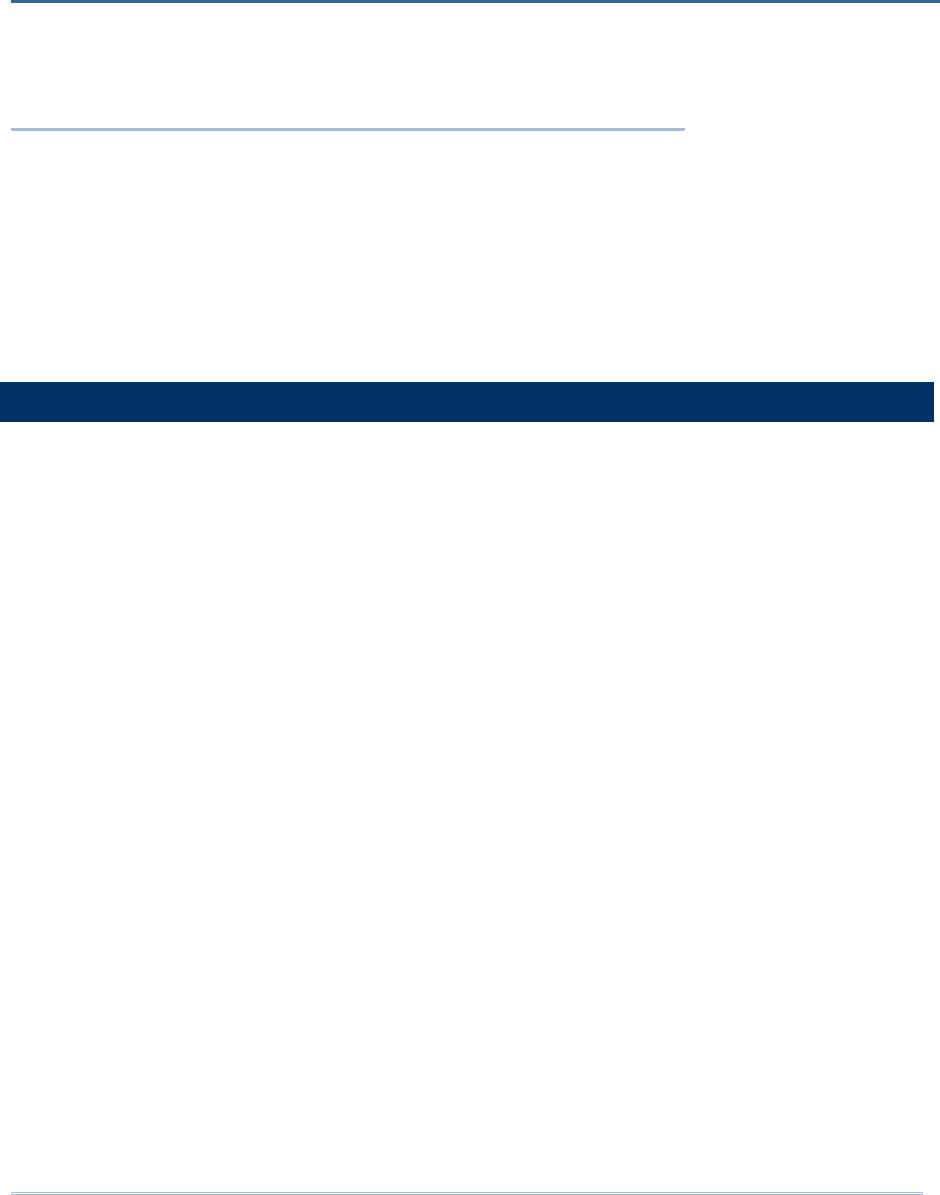
9
This chapter explains the features and usage of the terminal.
IN THIS CHAPTER
1.1 Battery ........................................................................................ 9
1.2 Memory .................................................................................... 15
1.3 Keypad..................................................................................... 18
1.4 Touch Screen........................................................................... 21
1.5 Notifications............................................................................. 24
1.6 Data Capture.......................................................................... 26
1.7 Communications .................................................................... 26
1.1 BATTERY
Main Battery
The terminal is powered by a rechargeable 3.7 V/1800 mAh Li-ion battery pack,
and it takes approximately 4 hours to fully charge it. However, the charging time
may vary by working condition. During normal operation, the mobile computer
can work for up to 10 hours.
Backup Battery
The backup battery on the main board takes charge when the main battery is
removed or drained out. When fully charged, the 3.7 V/70 mAh rechargeable
Lithium button cell helps retain data in SRAM and maintain the system running in
suspend mode for at least 20 hours without the main battery. In the meantime,
you have to replace the main battery as soon as possible.
Chapter 1
USING THE TERMINAL

10
Terminal Reference Manual
1.1.1 INSERTING THE BATTERY
When you first receive the package, the rechargeable functionality of the backup
battery is turned off. It is controlled by a DIP switch inside the battery compartment
as shown below.
For shipping and storage purposes, save the mobile computer and the main battery
in separate packages, and adjust the DIP switch to the OFF position (bottom). This will
keep both batteries in good condition for future use.
Note: Any improper handling may reduce the battery life.
1) Press for the mobile computer to enter suspend mode.
2) Remove the hand strap.
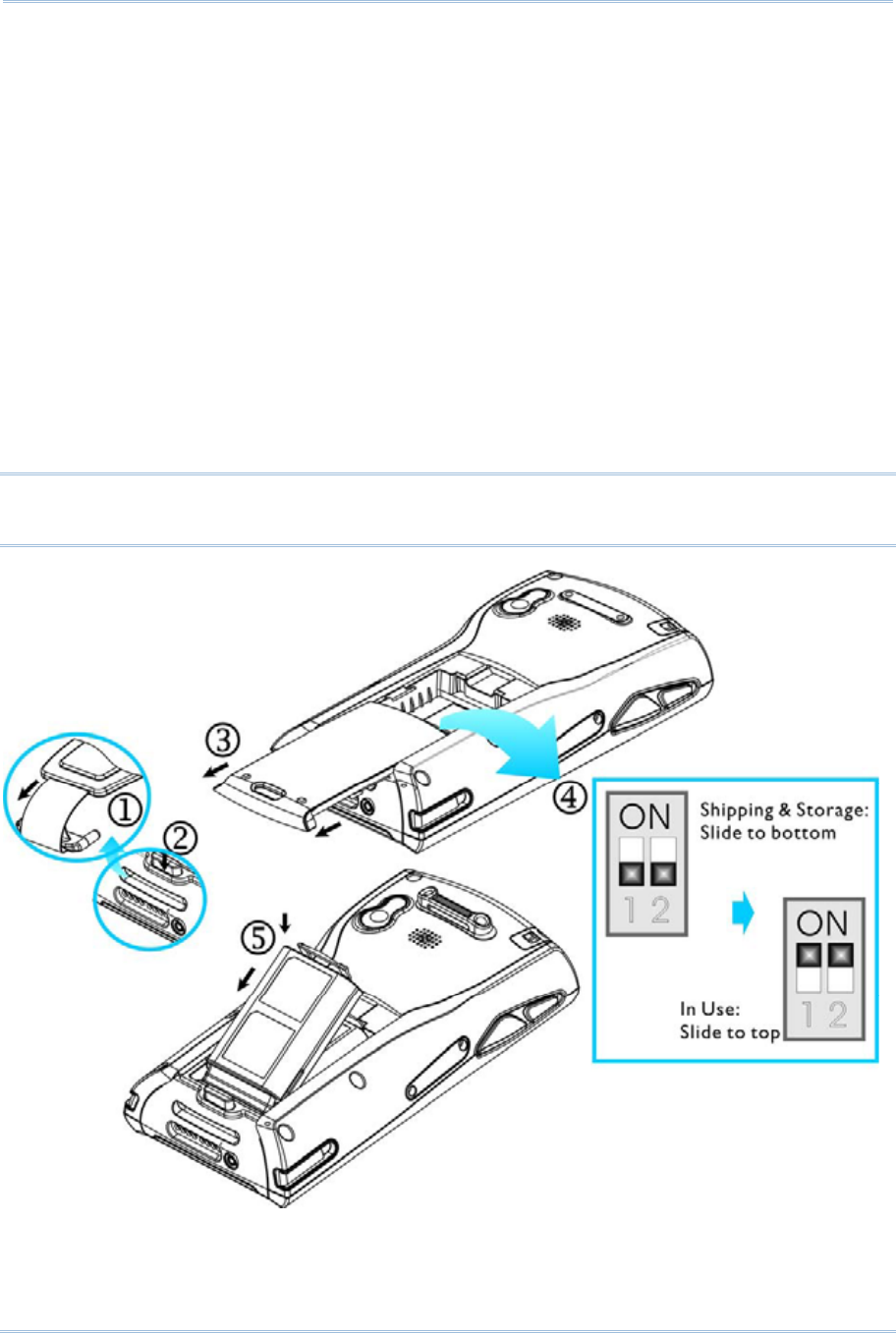
11
Chapter 1
3) Hold the mobile computer still and press the release button to unlock the battery
cover.
4) Slide off the battery cover.
5) Use the stylus (or a sharp-pointed object, such as a pencil) to adjust the DIP
switch to the ON position (top). Now the internal backup battery can be charged
by the main battery.
6) Insert the battery pack into the battery compartment at a proper angle (30°~45°)
so that the metal contacts on the battery are met with the charging contacts
inside the compartment. Make sure that the battery is snugly fit into the
compartment.
7) Slide the battery cover back onto the mobile computer until it clicks into place.
8) If the battery is charged, the mobile computer turns on.
If the mobile computer does not turn on, charge the battery.
Note: For a new battery, make sure it is fully charged before use. Always prepare a
spare battery pack, especially when you are on the road.
Figure 5: Installing the
Main Battery

12
Terminal Reference Manual
1.1.2 CHARGING THE BATTERY
The main and backup batteries may not be charged to full for shipment. When you
first receive the package, you will need to charge batteries to full before using the
mobile computer.
Note: To charge the batteries to full, it requires approximately 8 hours for the first time.
After the initial charging, it takes only 4 hours to charge the batteries to full.
Because the internal backup battery is constantly charged from the main battery,
the initial charging requires inserting the battery pack to the mobile computer and
then seating the mobile computer in the cradle for charging. This will have both the
main and backup batteries charged at the same time. To charge the backup
battery, make sure that you slide the DIP switch inside the battery compartment to
the ON position.
Note: For a new battery, make sure it is fully charged before use. Always prepare a
spare battery pack, especially when you are on the road.
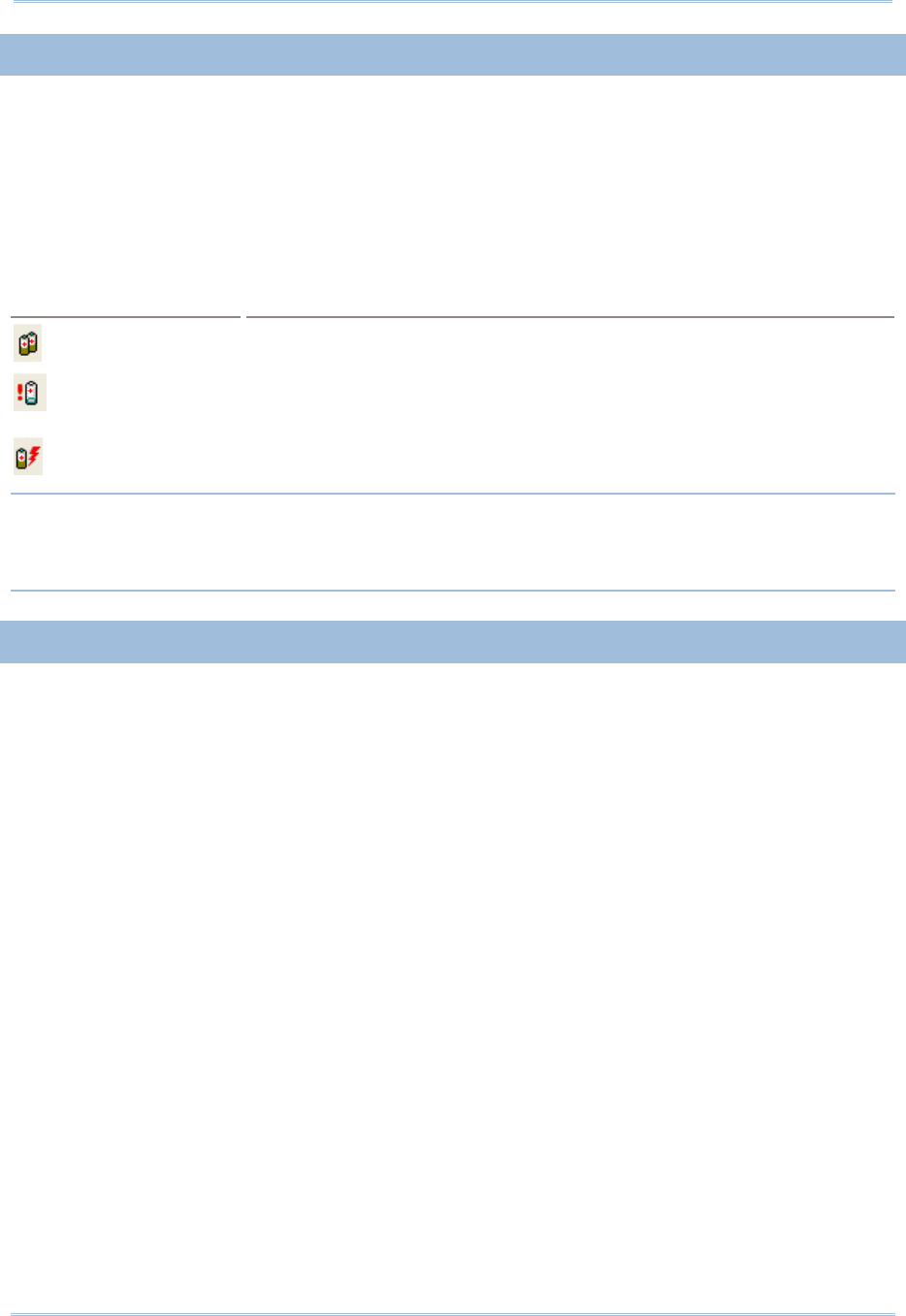
13
Chapter 1
1.1.3 UNDERSTANDING THE BATTERY ICONS
The battery pack is the only power source for the mobile computer to work. It also
charges the backup battery on the main board so that the data stored in SRAM can
be retained properly. Therefore, when the main battery charge goes low (see below
for battery status icon), you need to replace the battery pack with a charged one or
charge it as soon as possible. Most of all, always save data before it is too late; you
should backup important data on a regular basis.
BATTERY STATUS ICONS DESCRIPTION
Main battery charge becomes low. Main Battery
Main battery charge becomes very
low.
Charging Main battery is ready for charging.
Warning: Data loss may occur with SRAM during low battery condition. Always
save data before running out of power or keep a fresh battery for
replacement.
1.1.4 POWER MANAGEMENT
For any portable device, power management is a critical issue especially when you
are on the road. Below are some tips to help you save battery power.
To speed up charging the mobile computer, turn off the mobile computer and
seat it in the cradle.
Bring a second battery pack on the road.
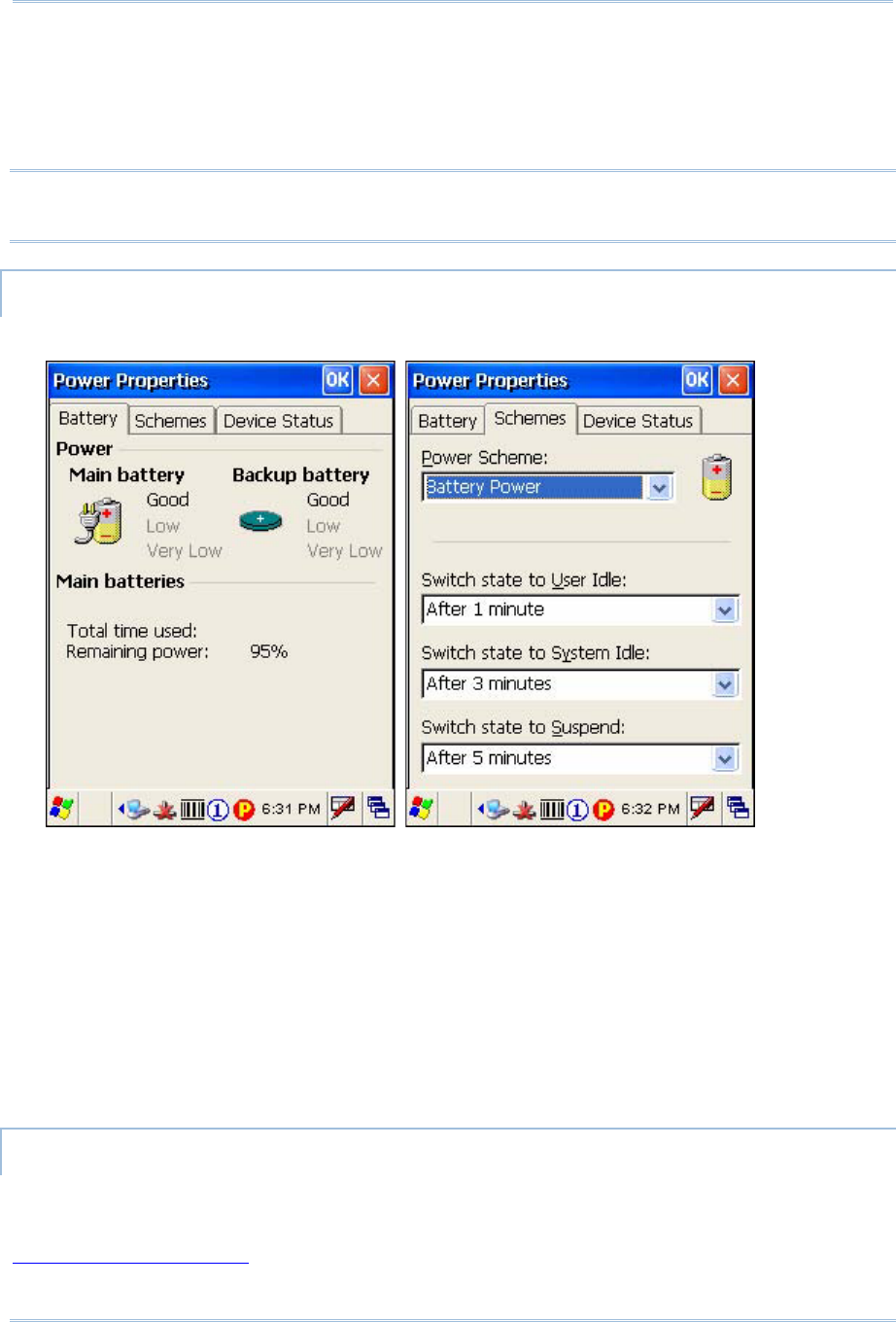
14
Terminal Reference Manual
Stop wireless connectivity, Bluetooth, or 802.11b that is not in use. Refer to the
Wireless Power Manager.
To save power, go to Start > Settings > Control Panel and select Display (for
backlight settings) or select Power (for power schemes).
Warning: Using backlight, wireless connectivity, and peripherals while on battery
power will substantially reduce battery life.
START > SETTINGS > CONTROL PANEL AND DOUBLE-TAP THE POWER ICON
1) In the Battery tab (left below), you can always monitor the charging status.
2) Tap the Schemes tab (right above).
3) Select the desired power scheme and options for suspending operation when not
in use. The system can be set to three different states to conserve power:
User Idle state
System Idle state
Suspend state
The time choices represent the amount of time that must pass before the system
will switch to the next power conservation state.
START > SETTINGS > CONTROL PANEL AND DOUBLE-TAP THE DISPLAY ICON
To conserve more power, you may go to Start > Settings > Control Panel and
double-tap the Display icon to configure the backlight setting. Refer to section 1.4.1
Adjusting the Backlight.
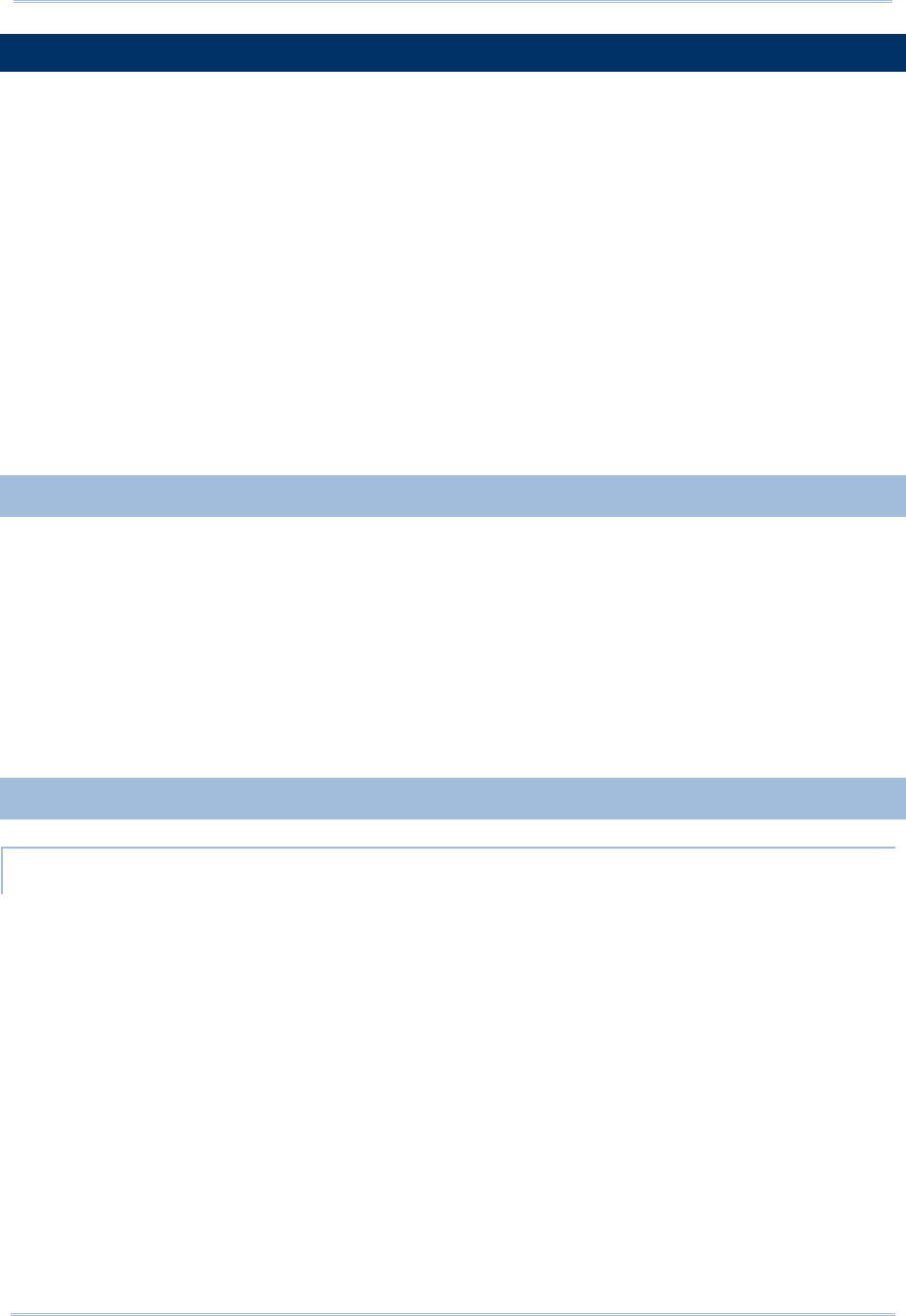
15
Chapter 1
1.2 MEMORY
Read-only Memory (ROM)
128 megabytes flash memory for storing OS (Windows CE 5.0) and custom
application programs. Yet a small portion of the memory is referred to as
DiskOnChip, which can store data and programs that you wish to retain even
after a hardware reset.
Random-access Memory (RAM)
64 or 128 megabytes SDRAM for storing and running programs, as well as storing
program data. Its contents will be retained by the backup battery.
Expansion Slot
The mobile computer is equipped with one miniSD card slot, which is user
accessible. You may upgrade memory by inserting an optional miniSD memory
card.
1.2.1 CAUTION OF DATA LOSS
When the main battery is removed or drained, the backup battery on the main
board is to retain the contents of SRAM and maintain the OS in suspend mode for at
least 20 hours, on condition that the backup battery has already been fully charged.
If you want to put away the mobile computer for a couple of days, you should be
aware that data loss occurs when both the main and backup batteries discharge
completely. Therefore, it is necessary to backup data and files before putting away
the mobile computer!
1.2.2 CHECKING THE STORAGE SPACE
START > SETTINGS > CONTROL PANEL AND DOUBLE-TAP THE SYSTEM ICON
1) In the Memory tab (left below), it displays the current capacity and usage of the
onboard SDRAM, 64 MB / 128 MB.
2) You may tap, hold, and drag the slider to re-allocate the memory.

16
Terminal Reference Manual
SDRAM STORAGE MEMORY (LEFT) PROGRAM MEMORY (RIGHT)
64 MB / 128 MB
onboard
It refers to the memory
allocated for file and data
storage.
It refers to the memory
allocated for running
programs.
(DESKTOP) MY DEVICE > DISKONCHIP
The DiskOnChip is part of the onboard 128 MB flash memory. Because the flash
memory is non-volatile, data or programs stored in DiskOnChip will not be erased
after a hardware reset.
Tap and hold the DiskOnChip icon to select Properties from the pop-up menu. In the
Properties tab (right below), it displays the current capacity and usage of
DiskOnChip.
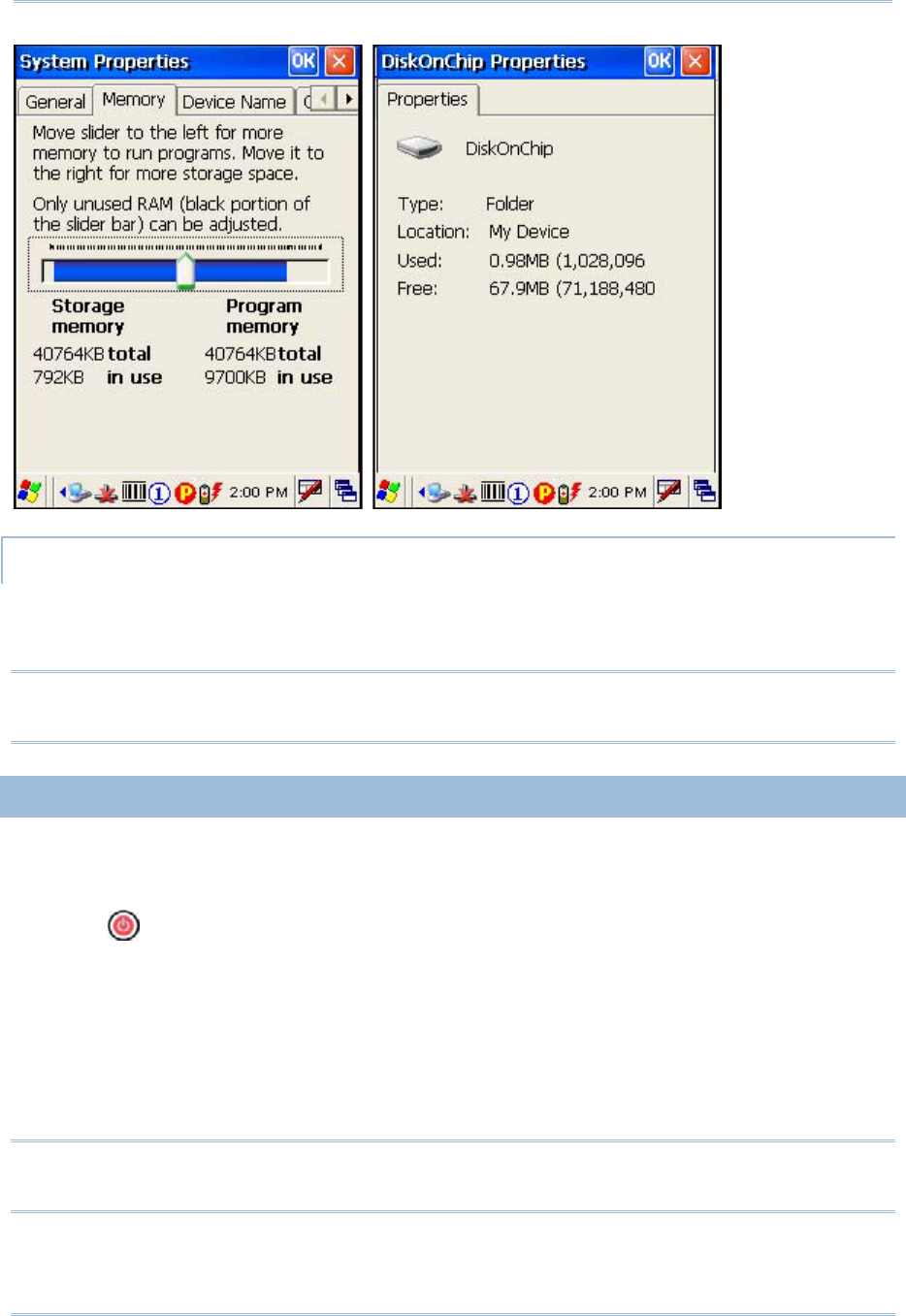
17
Chapter 1
START > SETTINGS > CONTROL PANEL AND DOUBLE-TAP THE STORAGE MANAGER ICON
Here provides a tool for administrators to reformat the DiskOnChip folder or storage
card (miniSD).
Warning: This tool is for the use of system administrators only. Everything on the
storage device will be permanently erased after reformatting.
1.2.3 INSERTING THE MINISD CARD
If you wish to expand memory, follow these steps to insert a memory card into the
miniSD card slot:
1) Press for the mobile computer to enter suspend mode.
2) Place the mobile computer face down on a flat and clean surface.
3) Remove the side plate by unscrewing the two screws (on the right side when you
place the mobile computer face down) as shown below.
4) Insert the miniSD card properly.
5) Replace the side plate and tighten the screws.
Warning: Make sure the mobile computer is set to Suspend mode; otherwise, it
may cause damage to the mobile computer.
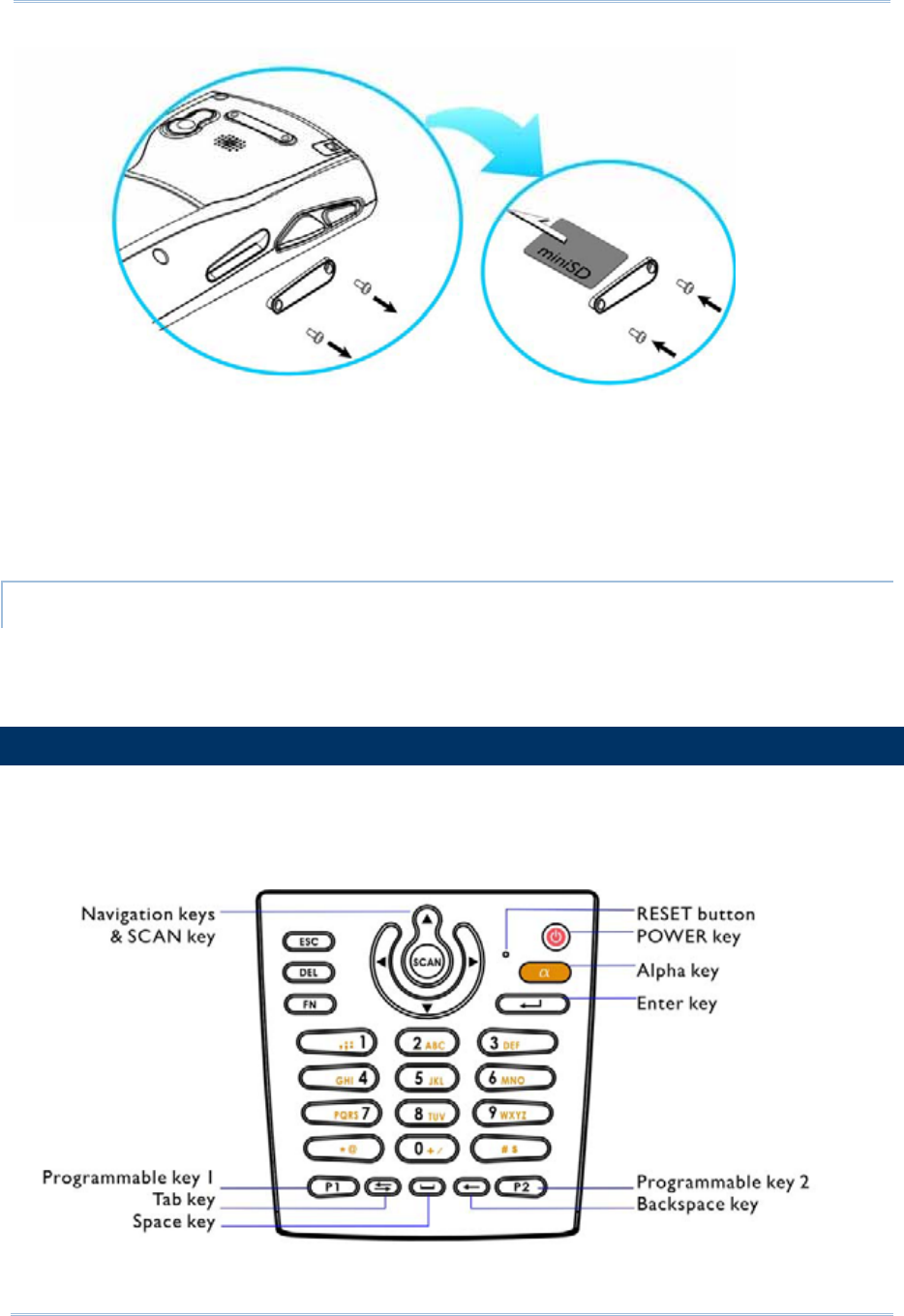
18
Terminal Reference Manual
REMOVING THE MINISD CARD
If you wish to remove the miniSD card, simply push the card after removing the side
plate. The miniSD card will be rejected automatically.
1.3 KEYPAD
Silicon rubber has been chosen for their durability and prompt feedback. The 28-key
keypad includes alphanumeric, navigation, function keys, and so on. This keypad is
set to numeric mode by default.
Figure 6: Inserting the
miniSD Card
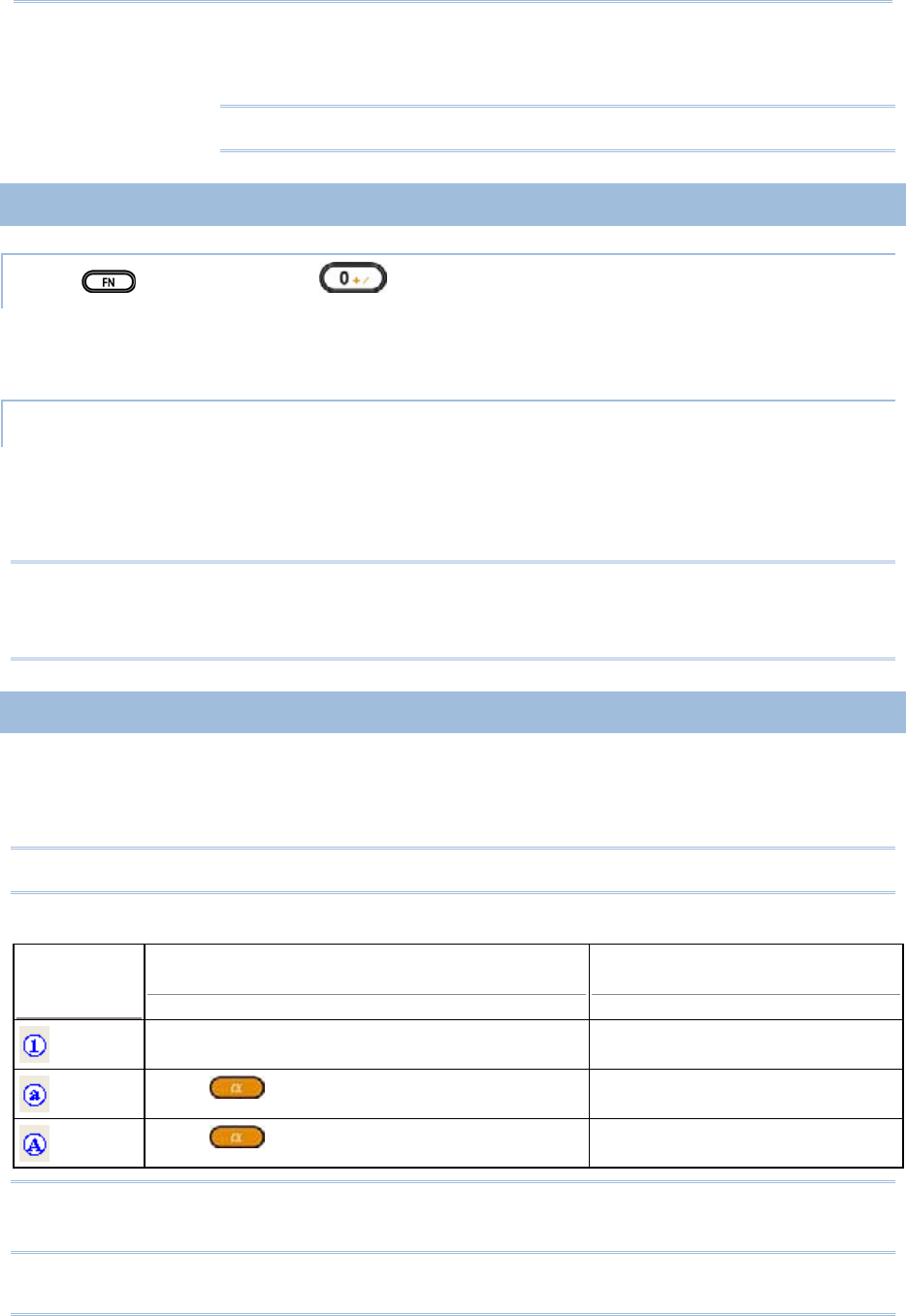
19
Chapter 1
Note: Functionality of keys is application-dependent.
1.3.1 USING THE KEYPAD
PRESS FIRST, AND THEN
The LED backlight of keypad is turned off by default. It can be toggled ON/OFF by
the key combination: [Func] + [0].
START > SETTINGS > CONTROL PANEL AND DOUBLE-TAP THE KEYBOARD ICON
The Character Repeat functionality is enabled by default. You may cancel the
check box to disable it. When enabled, tap, hold, and drag the slider for a desired
Repeat Delay and Repeat Rate.
Warning: It is suggested to turn on the keypad backlight while working in a dark
area; however, using backlight while on battery power will substantially
reduce battery life.
1.3.2 ALPHA KEY
This alphanumeric keypad is set to numeric mode by default. The Alpha key serves as
a toggle among numeric, alpha (lower-case alphabetic), and ALPHA (upper-case
alphabetic) input modes.
Note: It is not necessary to hold down the [Alpha] key.
The alpha icon will appear on the status bar in a sequence as shown below.
STATUS
ICON
ALPHA KEY INPUT MODE
N/A Numbers
Press one time Small letters
Press two times Capital letters
Note: If you are using the software keypad via SIP, tap CAP (Caps Lock) to toggle
between upper case and lower case alphabetic modes.
Figure 7: 28-key
Layout
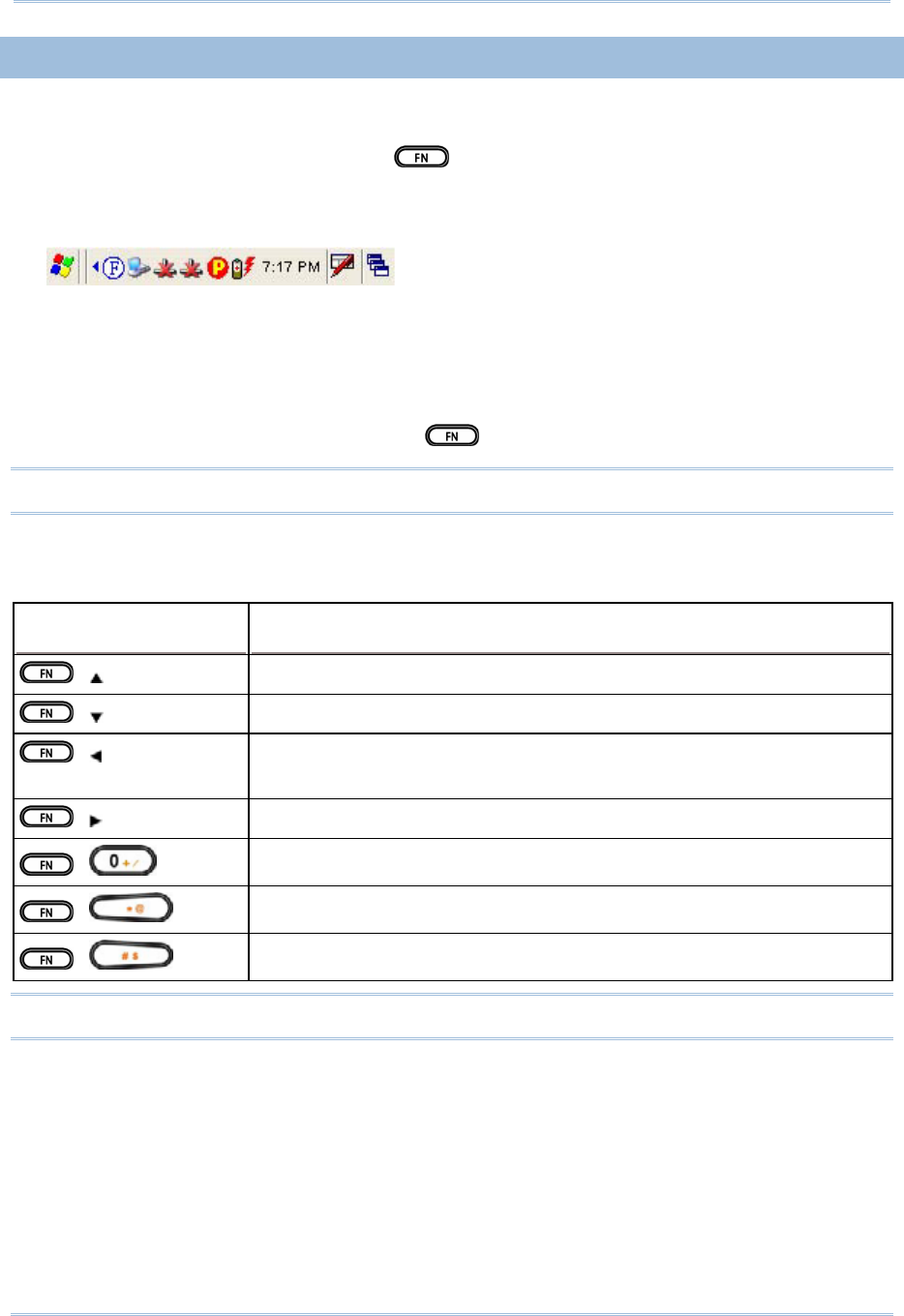
20
Terminal Reference Manual
1.3.3 FUNCTION KEY
The [Func] (function) key serves as a modifier key.
1) To enable this modifier key, press on the keypad.
A circular icon of the letter "F" will appear on the status bar. This modifier key is
hold down as long as the icon is displayed.
2) Now press another key to get the value of key combination (say, press [1] to get
the value of F1). The icon will go off now.
3) To get the value of another key combination modified by the [Func] key, repeat
the above steps.
4) To abort the key modification, press again, and the icon will go off.
Note: It is not necessary to hold down the [Func] key.
The functionality of each key combination is application-dependent. Below is a list of
the factory setting for a variety of key combinations.
KEY COMBINATION ACTION
,PgUp (red-coded): move text up one screenful
,PgDn (red-coded): move text down one screenful
,Home (red-coded): move to the beginning of screen or
document
,End (red-coded): move to the end of screen or document
,Toggle ON/OFF the backlight of keypad only
,Turn ON the backlight of LCD and decrease its luminosity
,Turn ON the backlight of LCD and increase its luminosity
Note: Press the [Func] key first, and then press the second key for a specific function.

21
Chapter 1
1.3.4 PROGRAMMABLE KEYS
Two user-definable keys, named P1 and P2, are provided on the keypad. Together
with the SCAN key as well as the four side triggers on each side of the touch screen,
they can be re-defined as another key or to serve as a shortcut key for launching a
specific program.
Refer to the Button Assignment Utility.
Note: By default, the four side triggers are programmed to serve as ENTER keys
(upper ones) as well as SCAN keys (lower ones).
1.4 TOUCH SCREEN
The mobile computer comes with a 3.5" TFT graphic LCD, 320 by 240 pixels resolution
(QVGA).
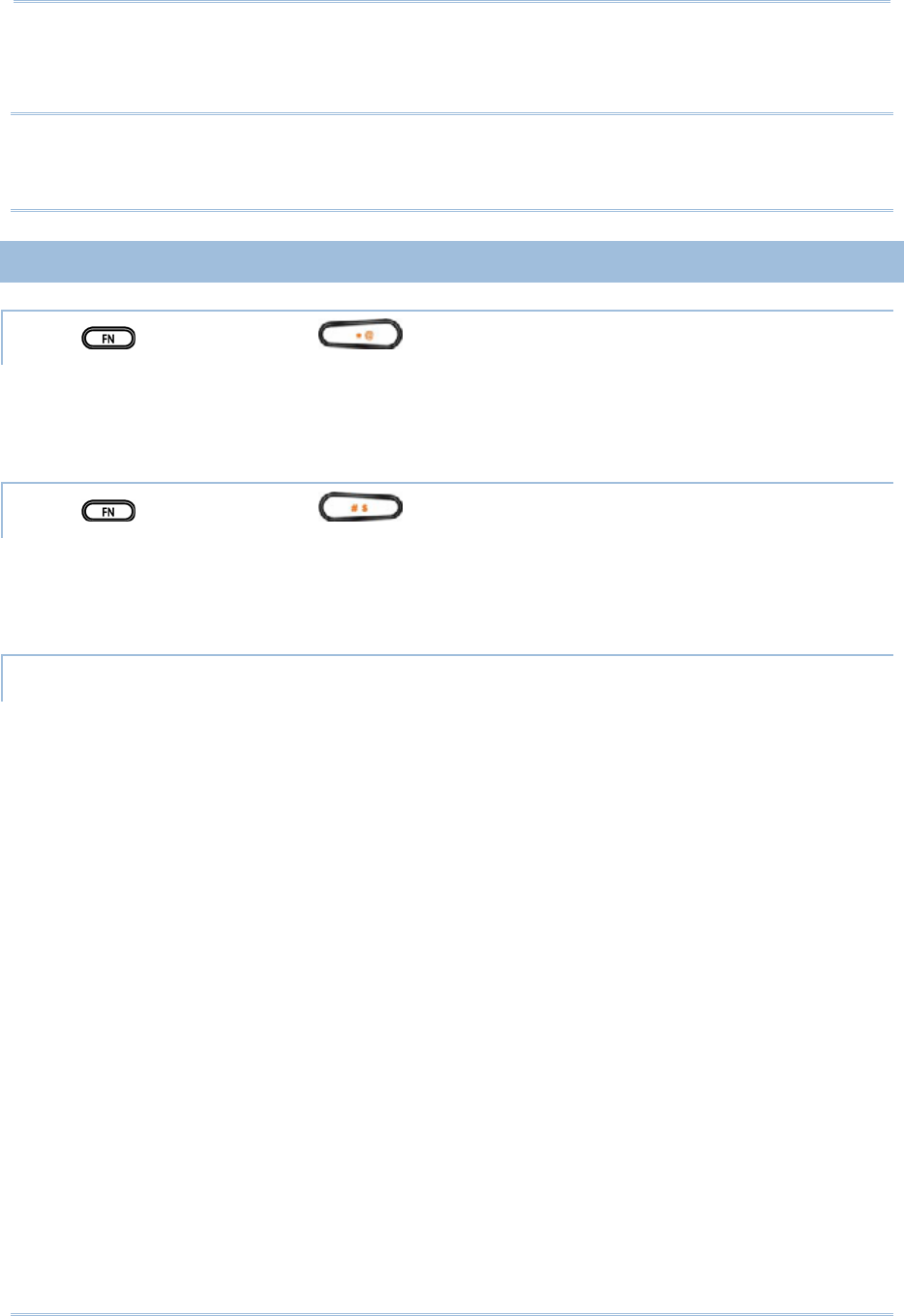
22
Terminal Reference Manual
The LED backlight of screen, which helps ease reading under dim environments, can
be controlled manually and automatically.
Warning: Using backlight while on battery power will substantially reduce battery
life. It is suggested to dim the backlight while working in a well-lit area or
automatically turn off the mobile computer when not in use.
1.4.1 ADJUSTING THE BACKLIGHT
PRESS FIRST, AND THEN
The LED backlight of the screen can be turned on and adjusted decreasingly by the
key combination: [Func] + [-]. Keep pressing the key combination ([Func] first, and
then [-]) until the luminosity is decreased to a desired level.
PRESS FIRST, AND THEN
The LED backlight of the screen can be turned on and adjusted increasingly by the
key combination: [Func] + [.]. Keep pressing the key combination ([Func] first, and
then [.]) until the luminosity is increased to a desired level.
START > SETTINGS > CONTROL PANEL AND DOUBLE-TAP THE DISPLAY ICON
1) Tap the Backlight tab (left below).
2) Select one or both of the check boxes to automatically turn off the LCD backlight
when using batteries or external power. From the appropriate list, select the
amount of time the device should be idle before the backlight is turned off.

23
Chapter 1
3) Tap the [Advanced] button (right above).
4) In the Settings tab, you can select the luminosity of backlight when it is set to be
automatically turned on by pressing any key or tapping the screen. Tap, hold,
and drag the slider for AC and battery powered respectively. For more luminosity,
move the slider to the right.
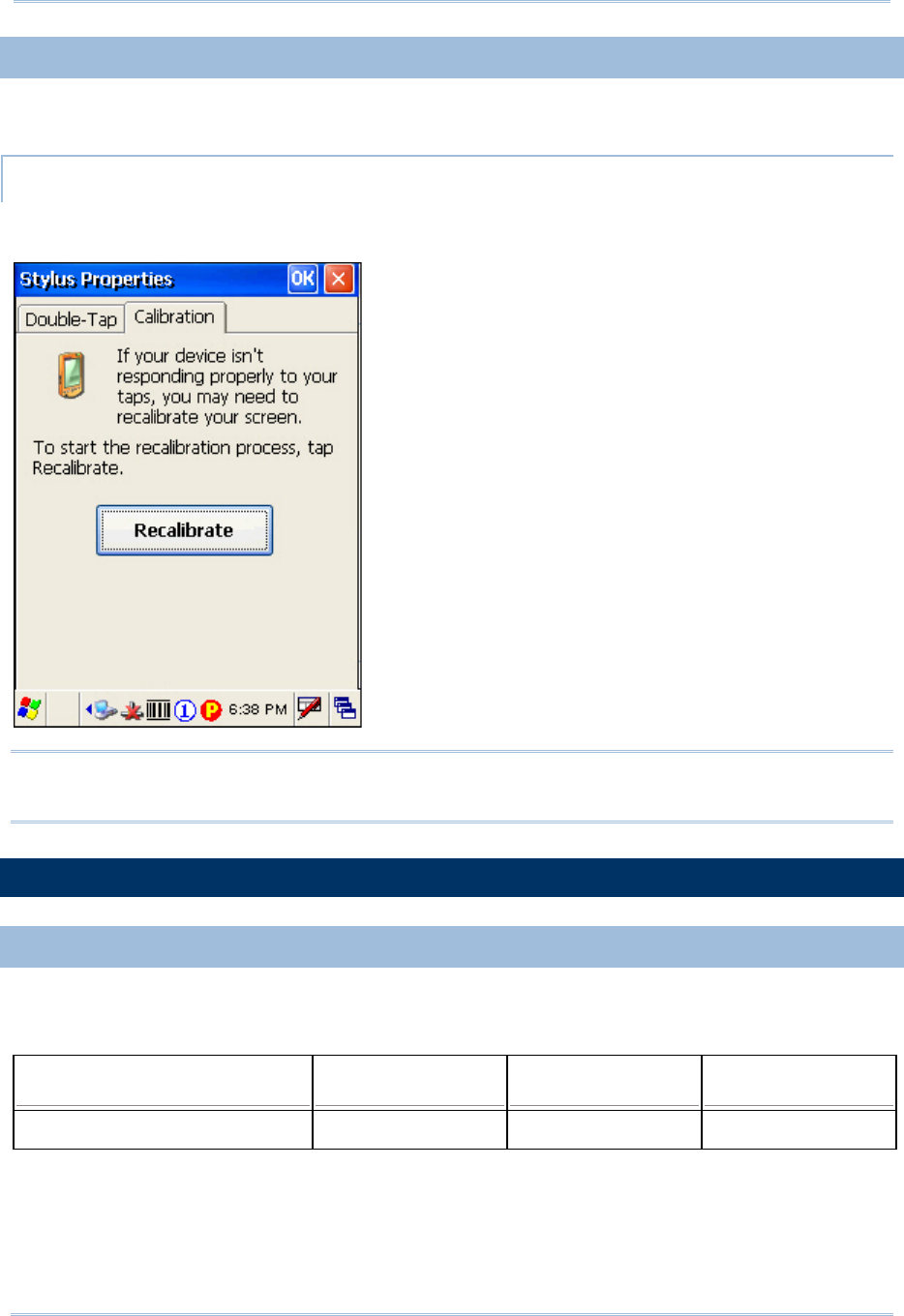
24
Terminal Reference Manual
1.4.2 RE-CALIBRATING THE SCREEN
This LCD is also a touch screen that can be calibrated through screen alignment.
START > SETTINGS > CONTROL PANEL AND DOUBLE-TAP THE STYLUS ICON
Tap the Calibration tab, and then tap the [Recalibrate] button.
Warning: DO NOT use any pointed or sharp objects to move against the surface
of the screen.
1.5 NOTIFICATIONS
1.5.1 STATUS LED
The tri-color LED on top is used to provide information on the charging status or
wireless power status.
TASKS GREEN LED RED LED BLUE
Charging 9400 --- On ---

25
Chapter 1
Charging done On --- ---
Good Read On --- ---
Bluetooth enabled --- --- On
Note: The green LED is also used for "Good Read" while collecting data.
1.5.2 AUDIO
Speaker
The mobile computer is integrated with a mono speaker, a low power transducer
type, used for playing sounds applied to events in Windows and programs, as well
as playing audio files such as .WAV files. In addition, it can be programmed for
status feedback.
Headset
A headset jack is provided, which is a 2.5 mm DIA stereo earphone jack with
microphone input. Bluetooth headset is also supported.

26
Terminal Reference Manual
1.5.3 VIBRATOR
The mobile computer is integrated with a vibrator, which is software programmable
for feedback. This can be helpful when working in noisy environments.
1.6 DATA CAPTURE
1.6.1 BARCODE & RFID READER
A wide variety of scan engines is available for delivering flexibility to meet different
requirements. Depending on the scan engine integrated (check the "Active Device"
setting in ReaderConfig), the mobile computer is capable of scanning barcodes of a
number of symbologies that are enabled by default. If you need to scan barcodes
that are encoded in a different symbology, use the Reader Configuration Utility to
enable the symbology first.
Refer to Appendixes for details on scan engine settings.
Appendix I – Scan Engine Settings lists the symbologies and RFID tags supported.
Appendix II – CCD/Laser Scan Engine provides information on the reader settings
as well as symbology settings for the CCD or Laser scan engine.
Appendix III – 2D Scan Engine provides information on the reader settings as well
as symbology settings for the 2D scan engine.
Note: The mobile computer allows the co-existence of one integrated scan engine
and the RFID reader.
1.6.2 DIGITAL CAMERA
An integrated 2 mega-pixel CMOS camera inside the computer is specifically
designed for collecting image data. Refer to the Image Capture Utility.
1.7 COMMUNICATIONS
1.7.1 USING THE CRADLE
The cradle is designed for charging and communications at the same time.
1) Place the cradle on a flat and clean surface.
2) Connect the line of the power adaptor to the power jack on the back of the
cradle.
3) Connect the power adaptor to a suitable power outlet.
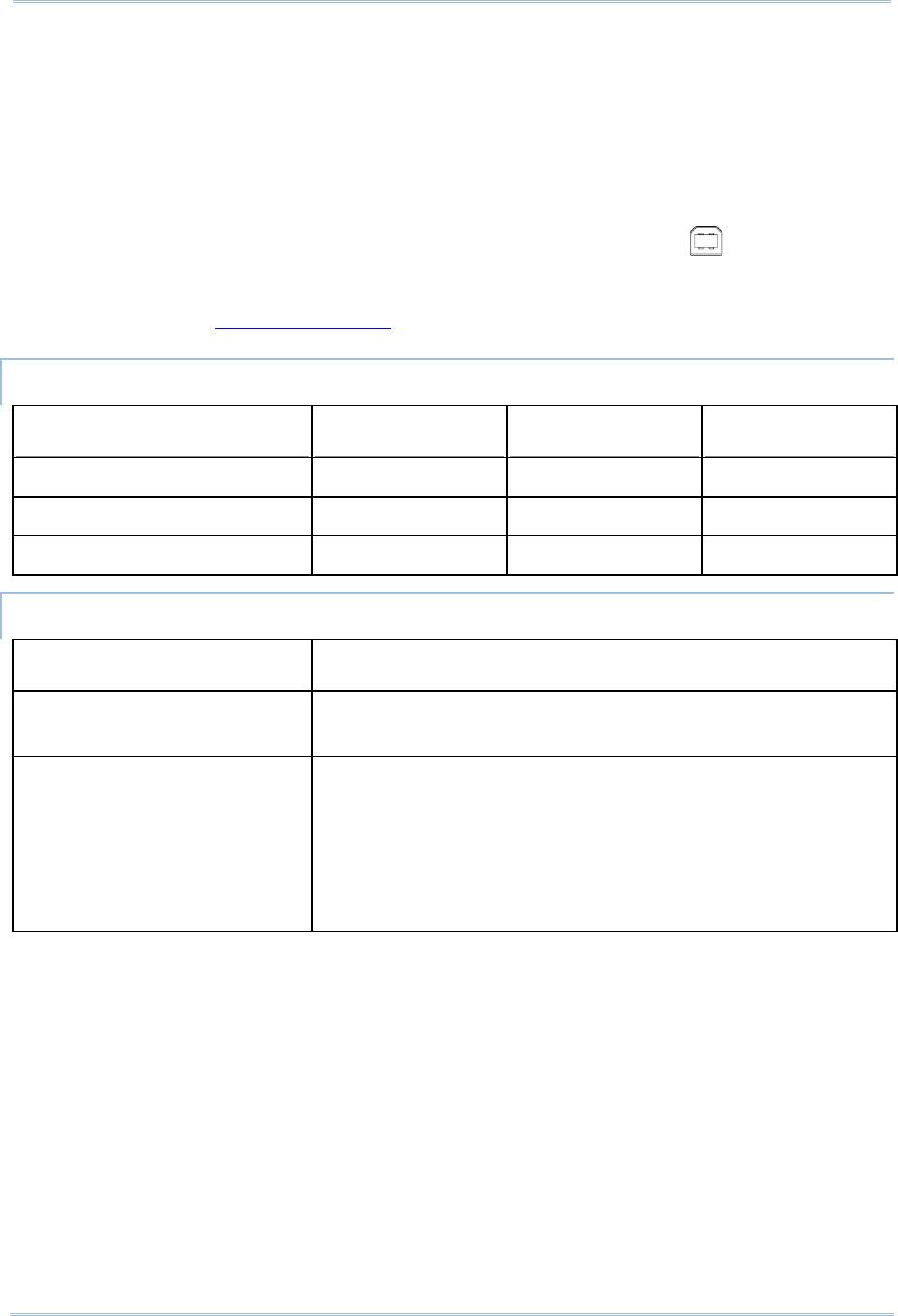
27
Chapter 1
4) The cradle is ready for charging.
5) Seat the mobile computer in the cradle.
If data communications are desired at the same time, you can establish a proper
connection with a computer or remote host. For example, you may establish a
USB connection for ActiveSync.
Make sure that you have Microsoft ActiveSync installed on your computer before
you connect the USB cable from the cradle's USB device port ( ) to your
computer.
Refer to section 2.3 Using ActiveSync.
UNDERSTANDING THE STATUS INDICATORS
TASKS GREEN LED RED LED BLUE
Power ON --- --- On
Charging Spare Battery --- On ---
Charging Done On --- ---
UNDERSTANDING THE COMMUNICATION PORTS
PORTS PURPOSE
USB Device Port This port is provided for connecting to your computer
for establishing a connection for ActiveSync.
USB Host Port This port is provided for connecting a USB device:
Keyboard
Mouse
Card reader
Storage device, such as a memory stick
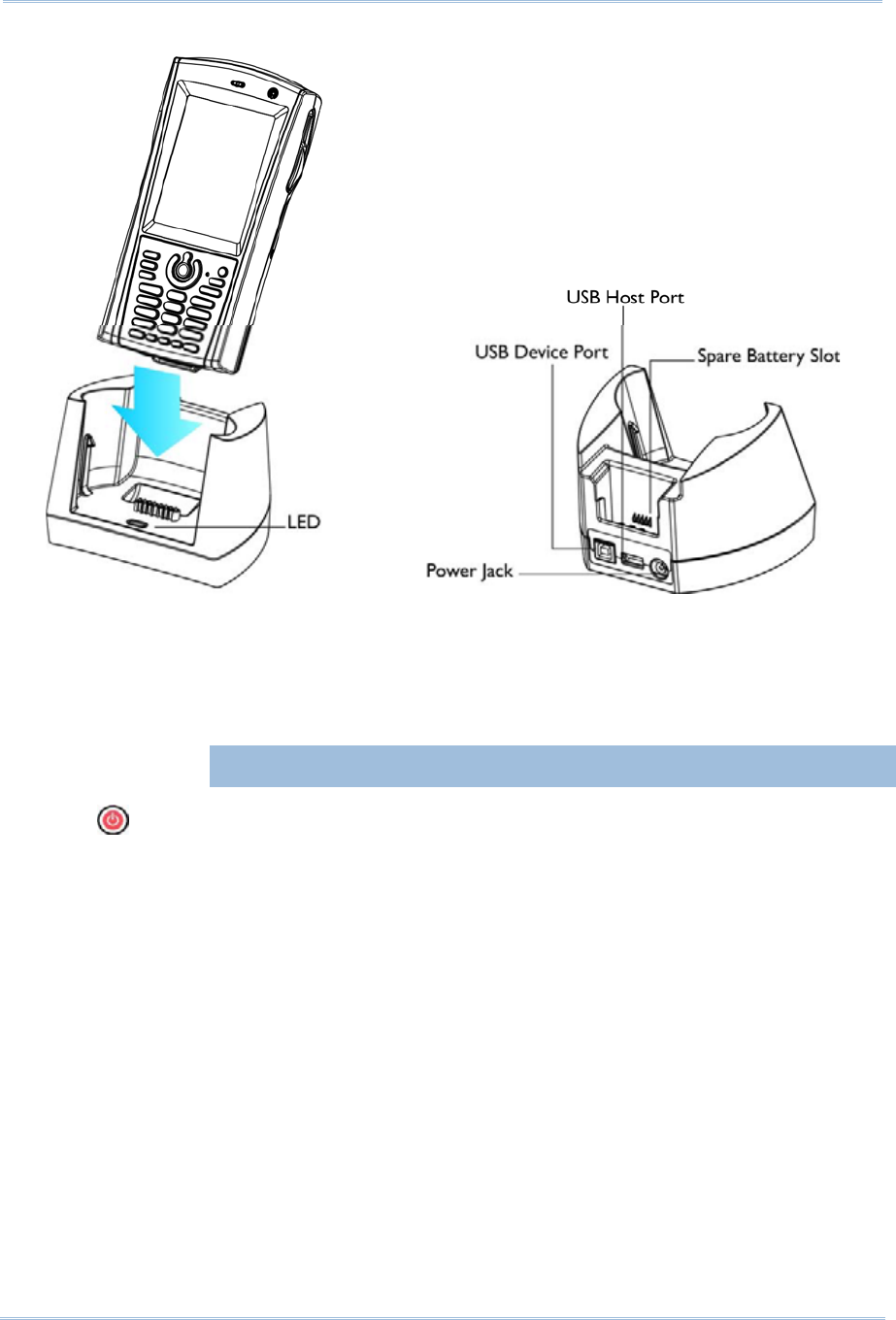
28
Terminal Reference Manual
1.7.2 INSERTING THE SIM CARD
1) Press for the mobile computer to enter suspend mode.
2) Hold the mobile computer still and remove the hand strap as well as the battery.
3) Use your finger to slide the locking plate towards its hinge to unlock the SIM card
holder.
Figure 8:
Understanding the
Cradle
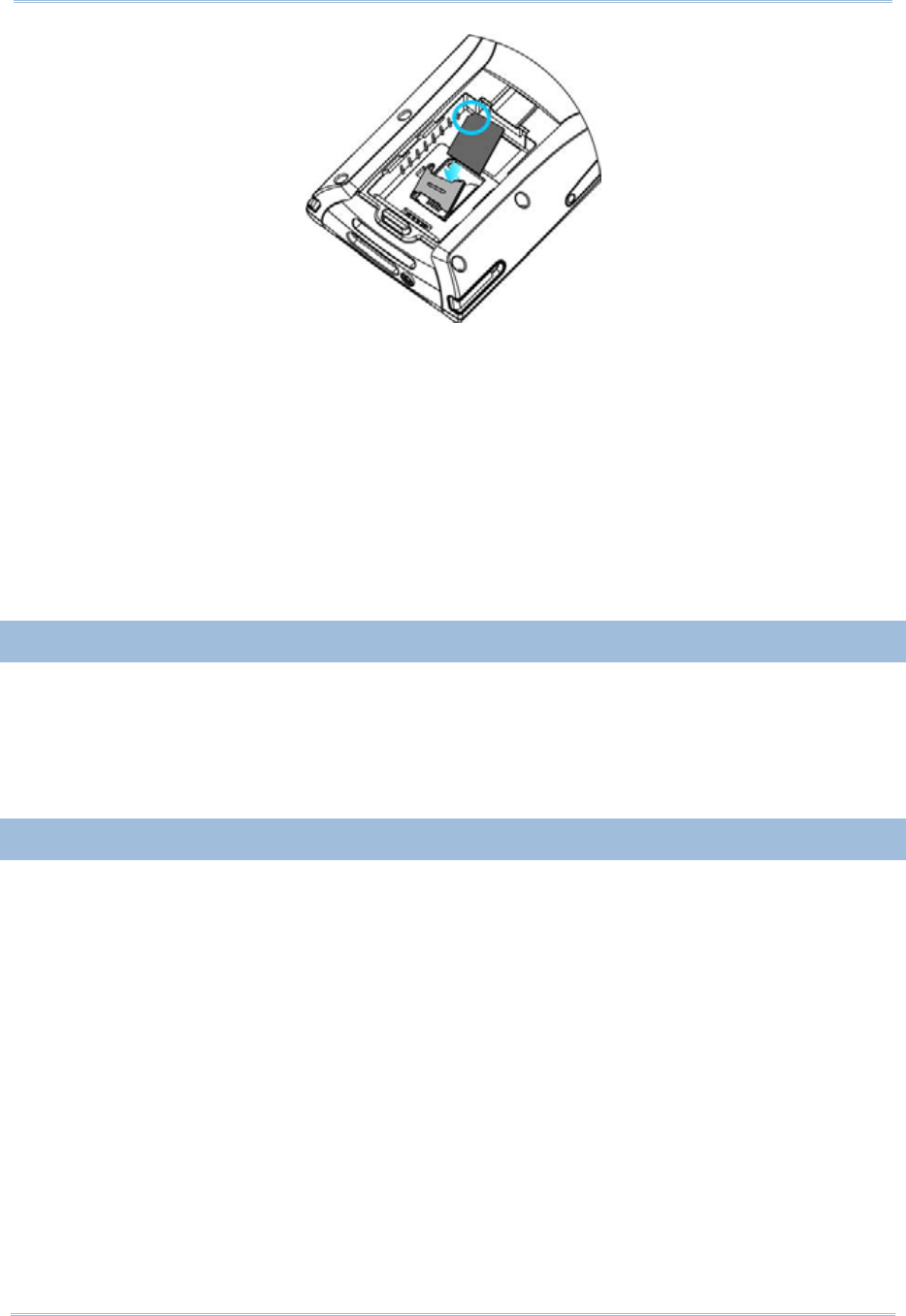
29
Chapter 1
4) Flip up the SIM card holder.
5) Insert the SIM card to the SIM card holder, using the card orientation shown
below.
6) Push the SIM card holder down.
7) Slide the locking plate away from its hinge to secure the SIM card holder.
1.7.3 TURN OFF THE WIRELESS NETWORKS
The mobile computer supports state-of-the-art wireless technologies, Bluetooth and
802.11b/g, so that it is able to send/receive data in real time in an efficient way.
Refer to the associated utilities.
1.7.4 USING THE HEADSET
Connect the headset to the headset jack (2.5 mm DIA) at the bottom of the mobile
computer. You can use the headset for audio playback or communication via Voice
over IP (VoIP).
Bluetooth headset is supported, bringing you the freedom of cordless mobility.
Figure 9: Inserting the
SIM Card

30
Terminal Reference Manual
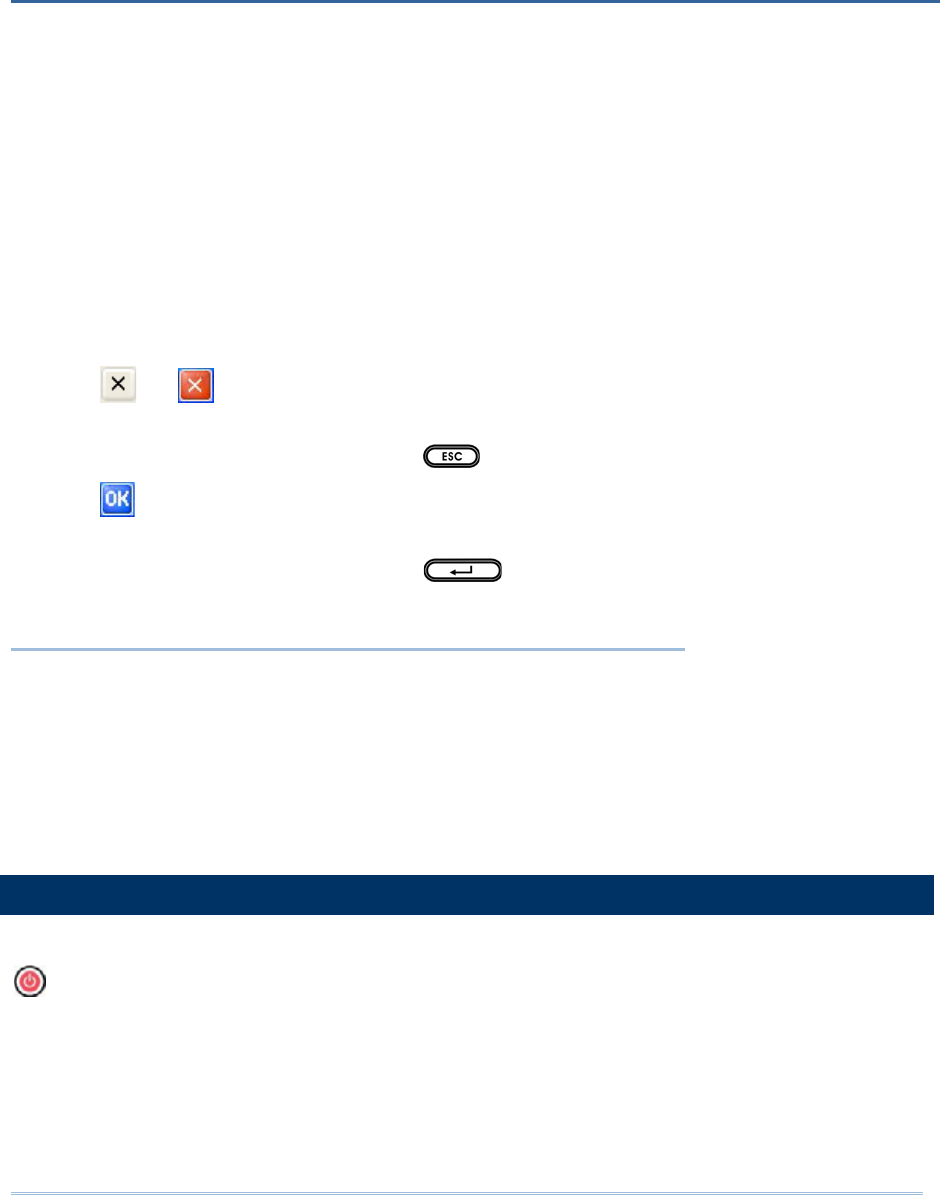
31
This chapter mainly describes the basic skills to work with the terminal. The add-on
utilities for applications regarding data collection, processing, and transmission, are
introduced in the following chapters.
The terminal is specifically designed for real-time data collection in the Windows CE
5.0 environment. It won't take long for any Windows user to get familiarized with it.
Keep these basic skills in mind and explore this Windows CE device at ease.
Double-tap an item to select it.
Tap and hold an item to see a menu that enables tasks, such as cut, copy,
rename, delete, etc.
Tap and drag to select multiple items.
Tap or on the toolbar to close an active window, a dialog box, or a
running application.
If the button is not displayed, press on the physical keypad.
Tap on the toolbar to save the current settings and exit the application (or
minimize the window in some applications).
If the button is not displayed, press on the physical keypad.
IN THIS CHAPTER
2.1 Getting Started ....................................................................... 31
2.2 Finding out the Capabilities of Your Mobile Computer... 38
2.3 Using ActiveSync .................................................................... 40
2.4 Managing Programs .............................................................. 43
2.5 System Reset & Auto Run ...................................................... 48
2.6 Updating OS Image ............................................................... 49
2.1 GETTING STARTED
When the terminal is fully charged, you may remove it from the cradle. Then, press
to turn on the mobile computer and wait for the Windows CE desktop to come
up. If you are using the mobile computer for the first time, there are a couple of
things to do after the desktop comes up.
To select your time zone and set the local time: Start > Settings > Control Panel
and select Date/Time.
To align the touch screen: Start > Settings > Control Panel and select Stylus.
Chapter 2
LEARNING WINDOWS CE BASICS
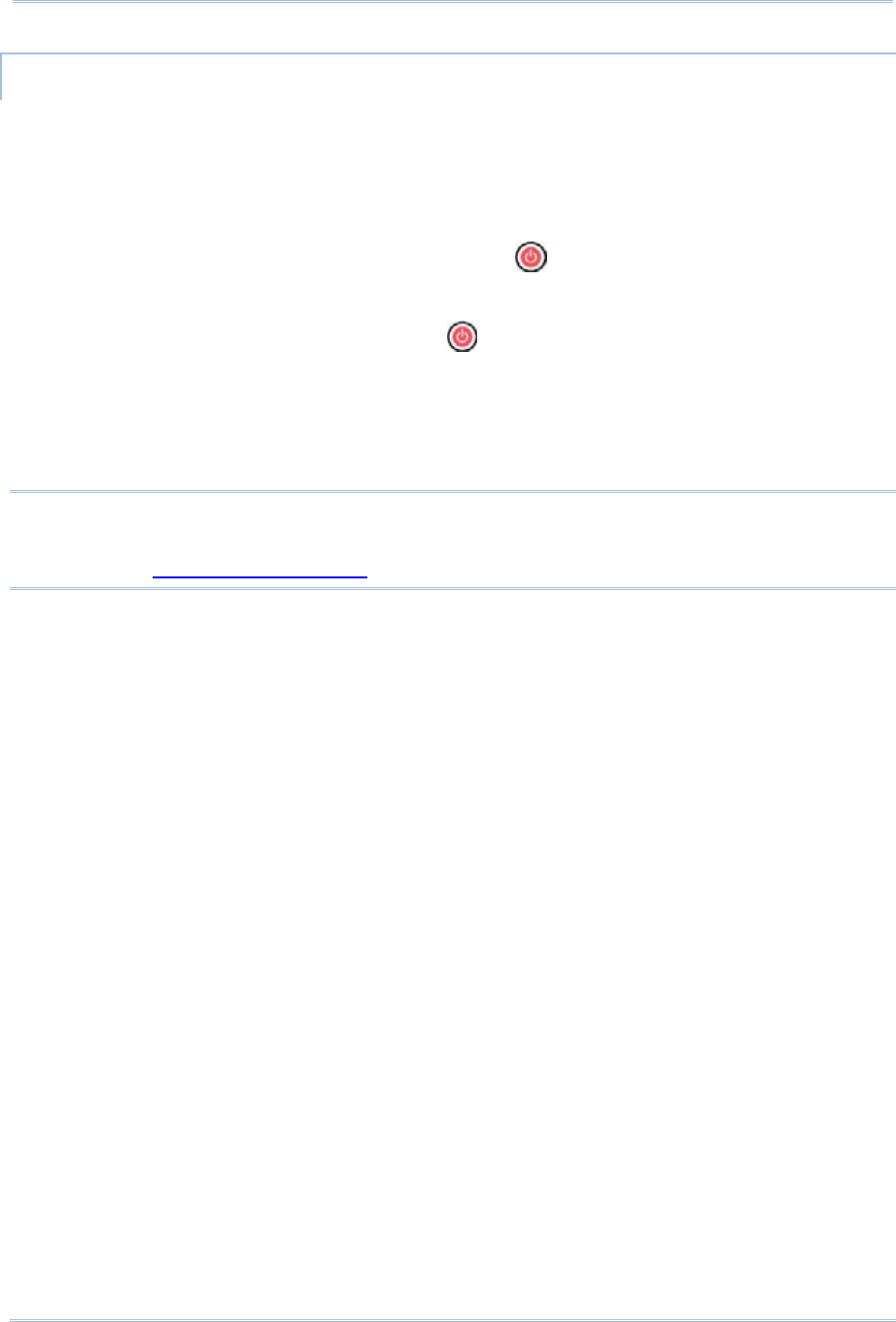
32
Terminal Reference Manual
SUSPEND MODE
Like your PDA, Pocket PC and most handheld devices, the terminal functions when it
is turned on. This is because the Windows CE operating system eliminates the booting
process and runs continuously.
Turn On (= Resume from Suspend)
To turn on the mobile computer, simply press .
Turn Off (= Suspend)
To turn off the mobile computer, press again, or select Suspend from the Start
Menu.
The system is now ready for use but not in use. This is referred to as Suspend mode
or Standby mode. It means the system is in power-saving status and waiting for
user interference.
Warning: To save battery power, it is suggested that the mobile computer is set
to be automatically turned off when not in use. Refer to section 1.1.4
Power Management for more information about saving power.
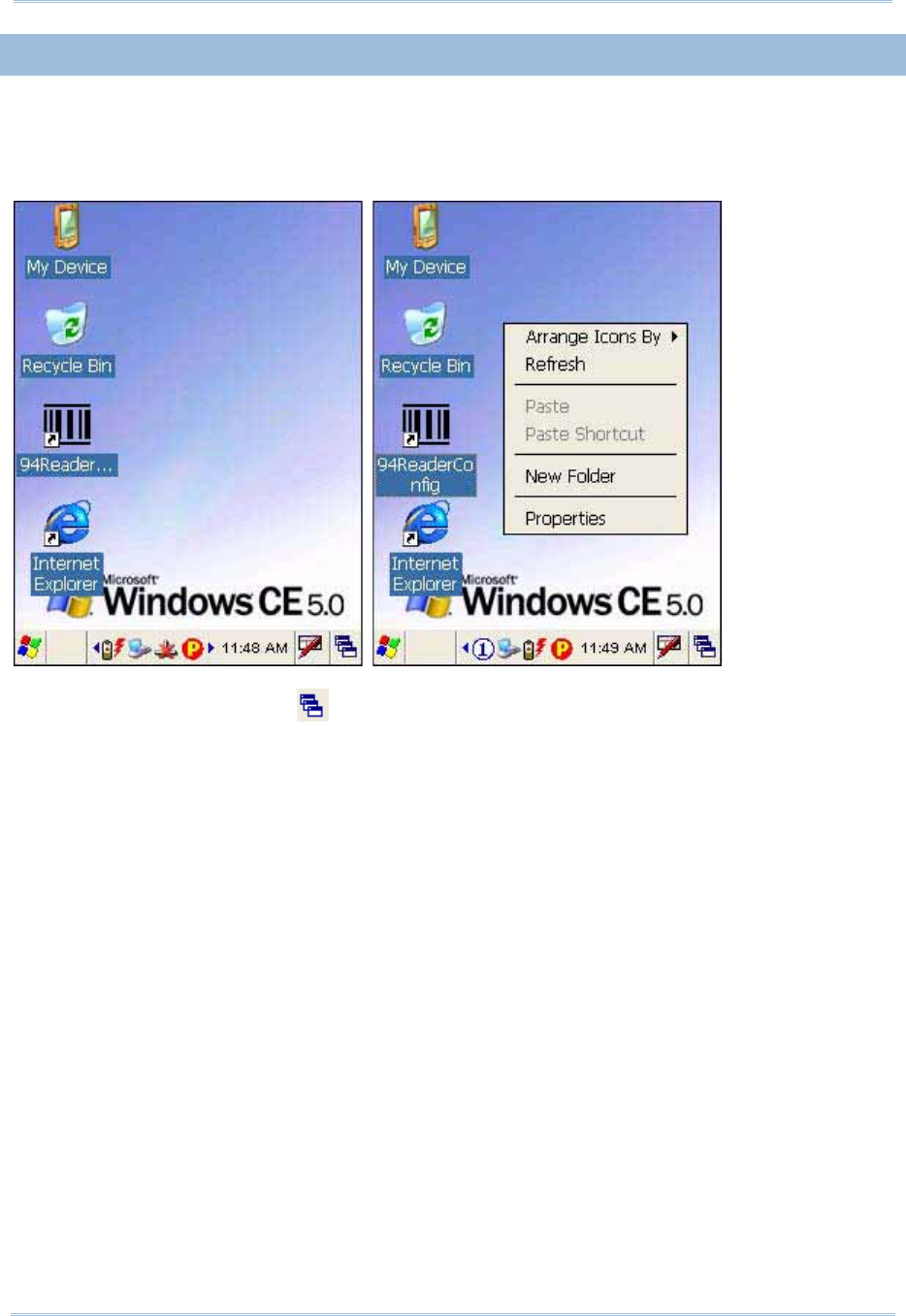
33
Chapter 2
2.1.1 DESKTOP
The desktop appears when the mobile computer is turned on (left below). Tap and
hold anywhere blank on the screen to manage or configure the desktop (right
below).
Alternatively, you may tap to the right of the taskbar, and then select Desktop.
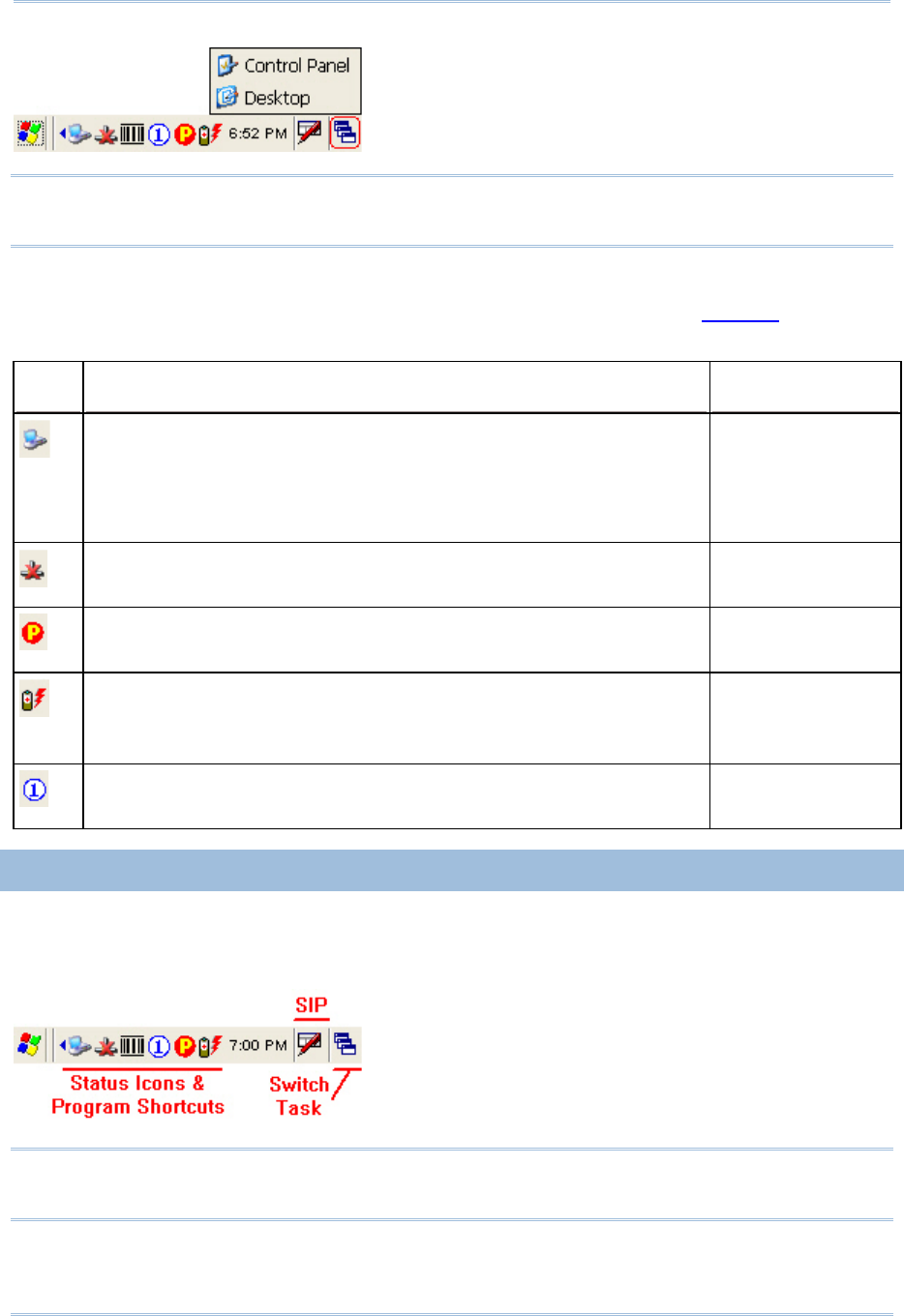
34
Terminal Reference Manual
Note: To customize the desktop, tap anywhere blank on the desktop and select
Properties.
When you turn on the mobile computer and seat it in the cradle for the first time, you
will find these icons displayed on the taskbar. Refer to section 2.1.2 Taskbar for more
information on the icons.
ICON DESCRIPTION SEE ALSO
This icon shows that your cradle is directly connected to a
computer via USB port.
Make sure you have Microsoft ActiveSync installed on
your computer.
1.7.1 Using the
Cradle
2.3 Using
ActiveSync
This icon shows that BTPAN1 is disabled. 3.1 Changing
System Settings
This icon is a shortcut to the Wireless Power Manager that
controls the power to 802.11b/g modules.
4.1 Wireless
Power Manager
This icon shows that the main battery is ready for charging.
For information on charging status, refer to the LEDs on the
mobile computer as well as on the cradle.
1.1.3
Understanding
the Battery Icons
This icon shows that numeric mode is in use for data input
via keypad.
1.3.4 Alpha Key
2.1.2 TASKBAR
The taskbar is at the bottom of the screen for displaying the Start button, status icons
for various connections or programs, SIP button, Switch Task button, etc.
Note: To configure different connections, go to Start > Settings and select Network
and Dial-up Connections.
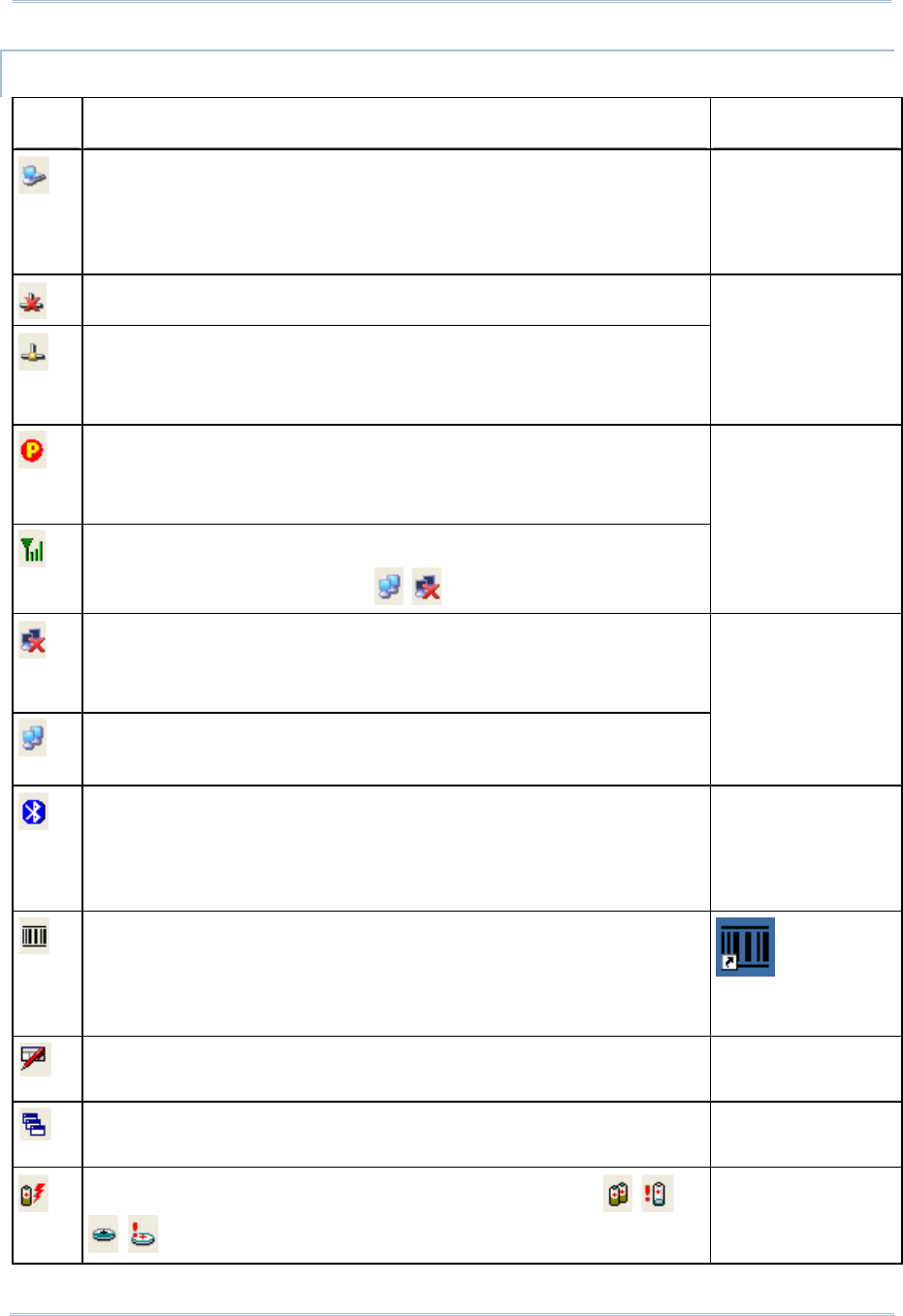
35
Chapter 2
UNDERSTANDING THE ICONS ON THE TASKBAR
ICON DESCRIPTION SEE ALSO
The USB connection for ActiveSync operation is successfully
established.
Double-tap it to view status. Tap [Disconnect] if
necessary.
3.2.1 USB
Connection (via
cradle)
The Bluetooth PAN connection fails. (= disconnected)
The Bluetooth PAN connection is successfully established
through the Bluetooth Manager utility.
Double-tap it to view or renew IP Information.
3.2.4 BTPAN
It provides control of the power to the 802.11b/g modules.
Double-tap any of these icons to configure the power
setting.
It indicates the Wi-Fi module (802.11b) is enabled.
See WLAN1 status icons below.
4.1 Wireless
Power Manager
The Wi-Fi connection fails. (= disconnected)
Double-tap it to access the Wireless Information tab for
establishing a new connection.
The Wi-Fi connection is successfully established.
Double-tap it to view or renew IP & Wireless Information.
3.2.3 WLAN
It provides access to the Bluetooth services.
Initially, you need to go to Start > Programs >
BTManager to open the Bluetooth Manager so that this
icon will appear on the taskbar.
4.2 Bluetooth
Manager
It provides access to the Reader Configuration Utility.
Initially, you need to double -tap the ReaderConfig
shortcut on the desktop so that this icon will appear on
the taskbar.
Tap it to change the input method. Software Input
Panel (SIP)
Tap it to switch to desktop or any task, such as a running
program or window.
Switch Task
It indicates the battery status. The other icons are
.
1.1.3
Understanding
the Battery icons
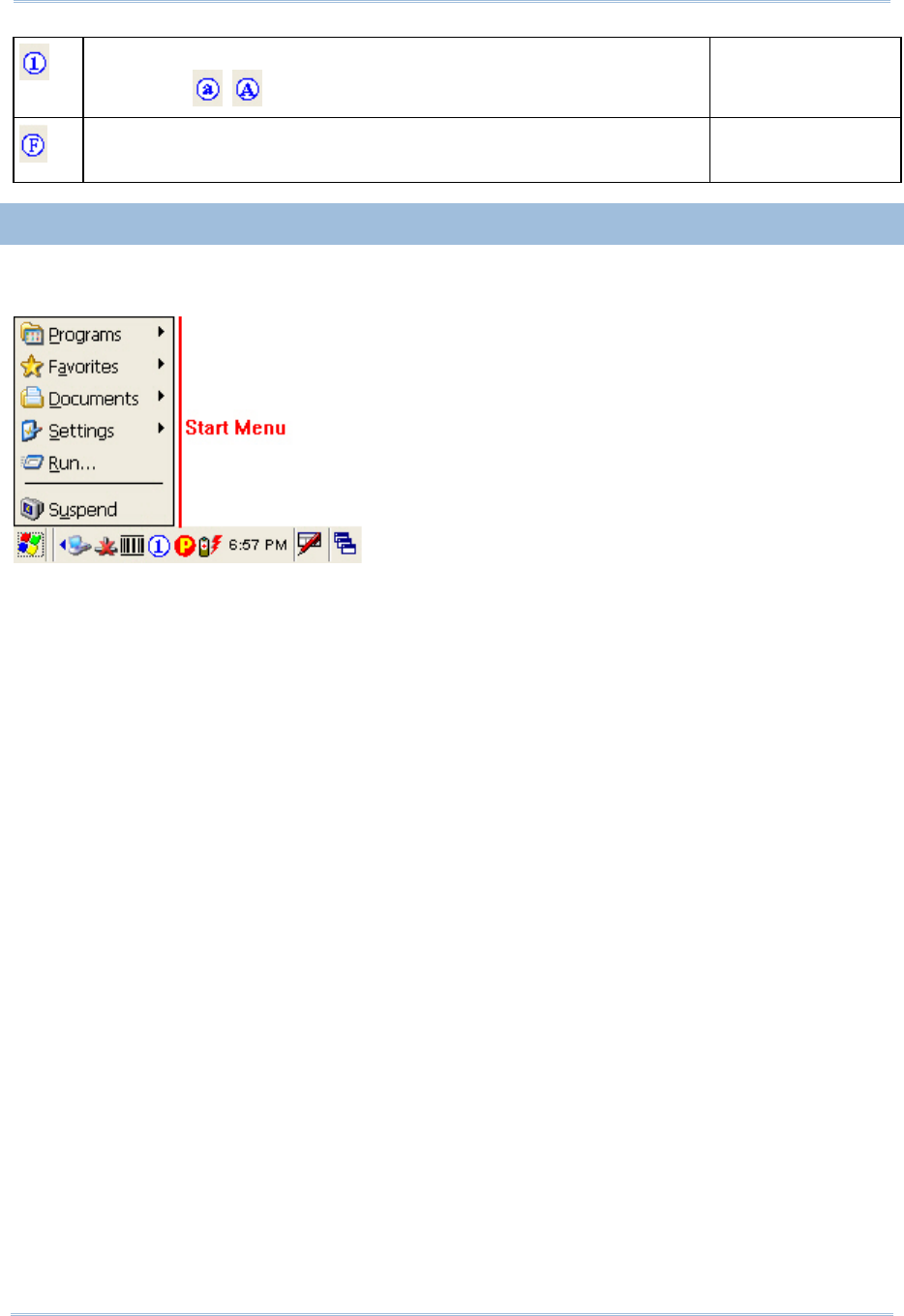
36
Terminal Reference Manual
It indicates the current input mode of keypad. The other
icons are .
1.3.4 Alpha Key
It indicates the modifier key is enabled. (= function mode) 1.3.5 Function
Key
2.1.3 START MENU
Tap the Start button on the taskbar to open the Start Menu.

37
Chapter 2
OPTIONS DESCRIPTION
Programs Provides access to available programs in the directory:
\Windows\Programs
Favorites Provides access to your favorites in the directory:
\Windows\Favorites
Documents Provides access to recent opened documents in the directory:
\Windows\Recent
Settings Provides access to Control Panel
Network and Dial-up Connections
Taskbar and Start Menu
Run... Runs a program or application.
Suspend Enters the Suspend mode.
Note: To configure the Start menu and taskbar, go to Start > Settings and select
Taskbar and Start Menu.
2.1.4 INPUT METHODS
Data entry can be performed by the following methods:
Type with the physical keypad.
Scan barcode or RFID tag in applications, e.g. WordPad, CipherLab's Application
Generator, etc.
Tap or write using SIP (Soft Input Panel)
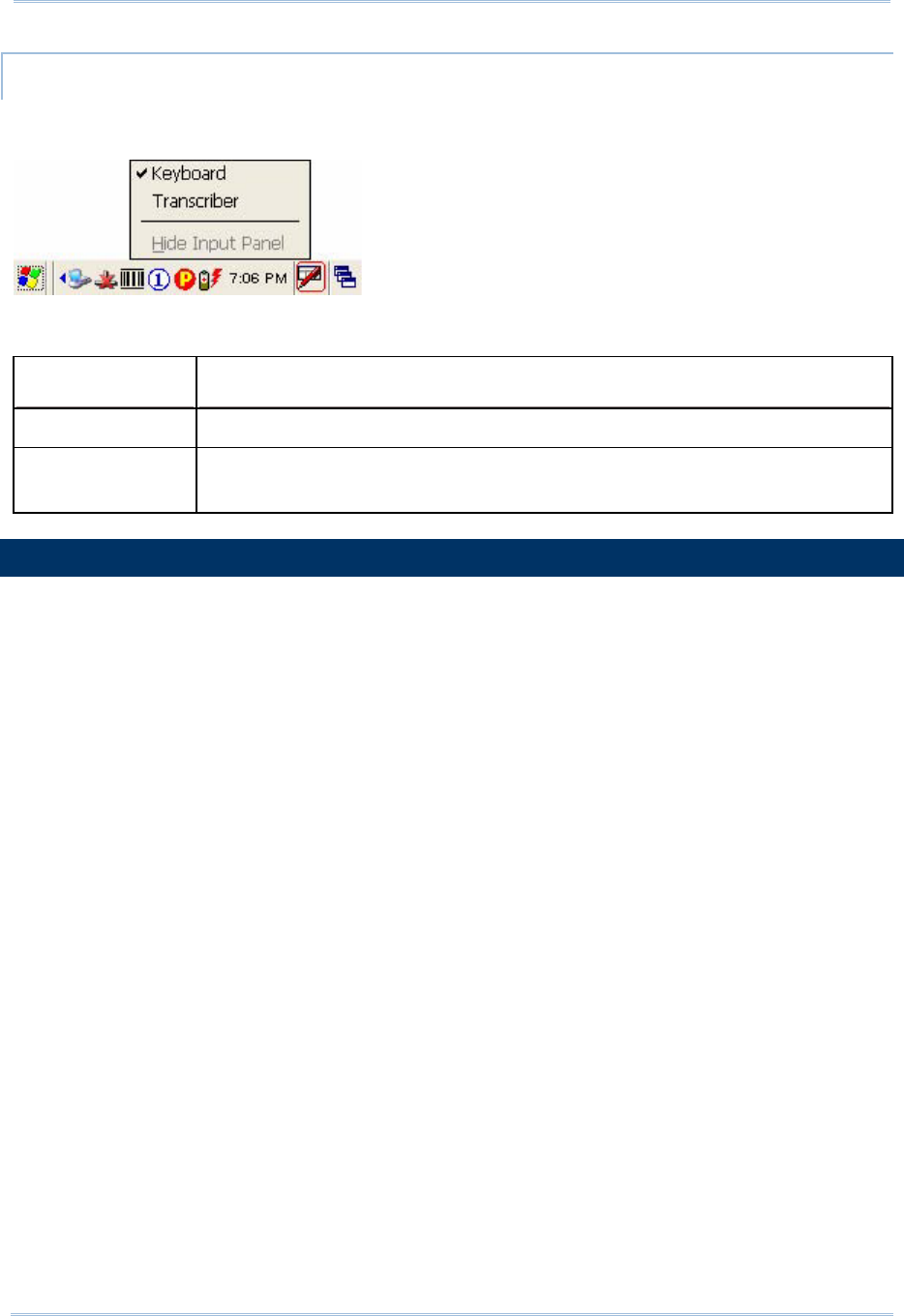
38
Terminal Reference Manual
USING THE SOFT INPUT PANEL (SIP)
Tap the SIP button on the taskbar to select a SIP mode or hide the input panel.
In each mode, the characters appear as typed text on the screen.
OPTIONS DESCRIPTION
Keyboard To type using the virtual keyboard.
Transcriber To write freely on the screen in applications, such as WordPad,
Inbox, etc.
2.2 FINDING OUT THE CAPABILITIES OF YOUR MOBILE COMPUTER
1) Go to Start > Settings > Control Panel and select System to obtain essential system
information.
2) Select the Device Name tab to change the identification for the mobile
computer.

39
Chapter 2
DEVICE CONFIGURATION CODE
The device configuration of terminal is displayed in 5 digits: xxxx-x
Take the screenshot of System Properties below for example. Its device configuration
is “2410-0”, which means the 28-key mobile computer has equipped with the
following parts:
A scan engine that employs Laser scan engine
Integrated Bluetooth and Wi-Fi modules module
An RFID reader
DEVICE CODE MODULAR COMPONENT TYPES
1st digit Reader module 0= none
1= CCD scan engine
2= Laser scan engine
3= 2D scan engine
2nd digit Wireless module 4= Bluetooth + 802.11b/g
5= Bluetooth only
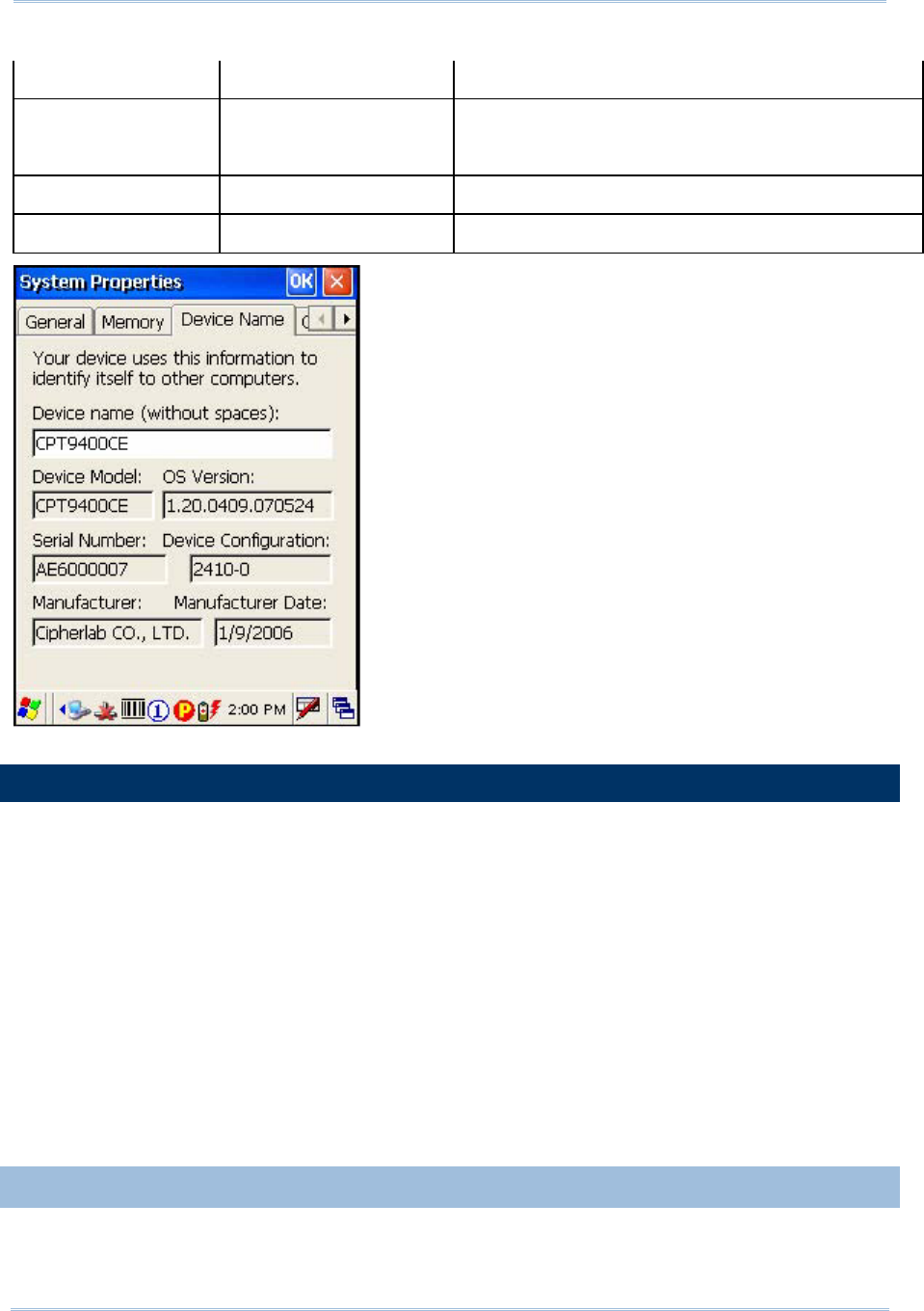
40
Terminal Reference Manual
3rd digit RFID module 0= none
1= RFID reader
4th digit Reserved ---
5th digit Keypad module 0= 28-key
2.3 USING ACTIVESYNC
ActiveSync is used to synchronize information between the terminal and your
desktop computer, to install programs on the mobile computer, and to backup and
restore the mobile computer.
The Microsoft ActiveSync program has to be installed on your desktop computer first.
To download the up-to-date version of the program, you may need to go to
Microsoft's official web site for Windows Mobile devices as shown below.
http://www.microsoft.com/windowsmobile/default.mspx
After downloading and installation, run the program. For detailed information on
the program, you may click the Help menu, and then select the Microsoft
ActiveSync Help.
2.3.1 SYNCHRONIZATION WITH YOUR COMPUTER
1) Follow these instructions for initial ActiveSync operation:
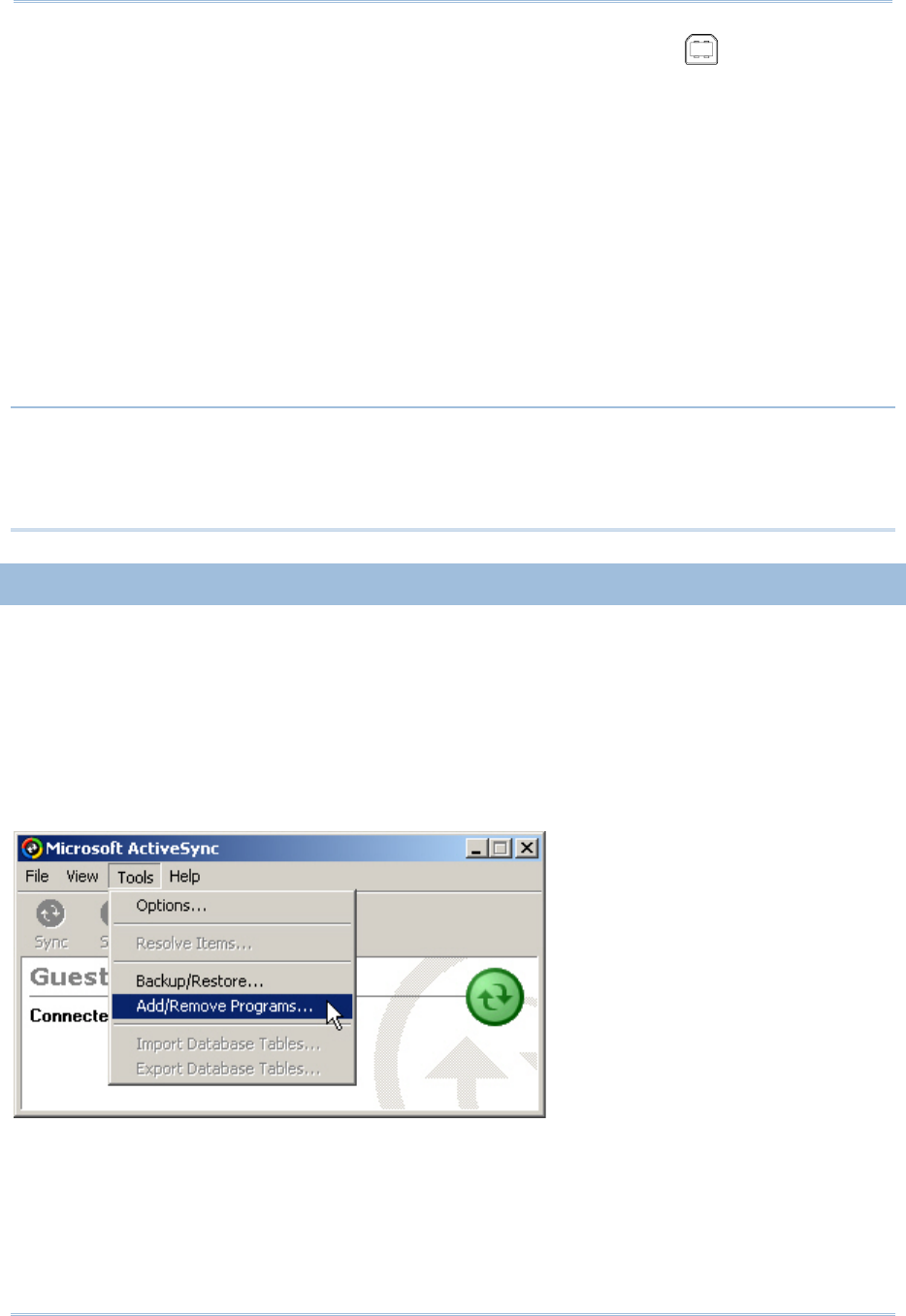
41
Chapter 2
Connect the USB cable from the cradle's USB device port ( ) to your
computer.
Connect the power cable from the cradle to a nearby power outlet.
Turn on the mobile computer and seat it in the cradle.
2) Your computer will automatically detect the USB device. Click [OK] when the
connection is established.
3) Select which partnership to set up. If you want to synchronize data between the
mobile computer and your personal computer, select Standard Partnership;
otherwise, select Guest Partnership.
4) Wait a few seconds for the mobile computer to get connected (and
synchronized if a Standard Partnership is selected).
Note: (1) For ActiveSync via Bluetooth, refer to the Bluetooth Manager.
(2) We recommend that you have ActiveSync 3.7.1 installed on your
computer because ActiveSync 4.x does not officially support Windows CE 5.0
devices.
2.3.2 ADD/REMOVE PROGRAMS
Click [Add/Remove Programs] from the Tools Menu so that you can proceed to
install a program that is designed to be used on a mobile device running Windows
CE.
If a user program is no longer desired, you may remove it from the system. Click
[Add/Remove Programs] from the Tools Menu so that you can proceed to un-install a
program that is designed to be used on a mobile device running Windows CE.

42
Terminal Reference Manual
ALTERNATIVE TO INSTALL NEW PROGRAMS (COPY & PASTE)
Alternatively, you may install a new program manually.
1) When connected, open the Microsoft ActiveSync window on your desktop
computer.
2) Click the Explorer button from the toolbar.
3) Navigate to the target folder, e.g. the Programs folder, depending on where you
wish to access the program.
4) Navigate through file folders on your computer to find the new program
(.CAB, .EXE, etc.)
5) Right-click the program and select [copy] from the pop-up menu.
6) Back to the target folder in step 3.
Right-click anywhere blank and select [Paste] from the pop-up menu.
7) On the mobile computer, go to Start > Programs and the new program will
appear.
ALTERNATIVE TO REMOVE PROGRAMS (CONTROL PANEL)
Alternatively, you may un-install a new program manually.
1) Go to Start > Settings > Control Panel and select Remove Programs.
2) Tap the name of the program that you want to delete.
3) Tap [Remove].
4) Tap [Yes] to un-install the program.
Note: If the program does not appear in the list of installed programs, you may use
Windows Explorer to locate it. Tap and hold the program to select [Delete]
from the pop-up menu.
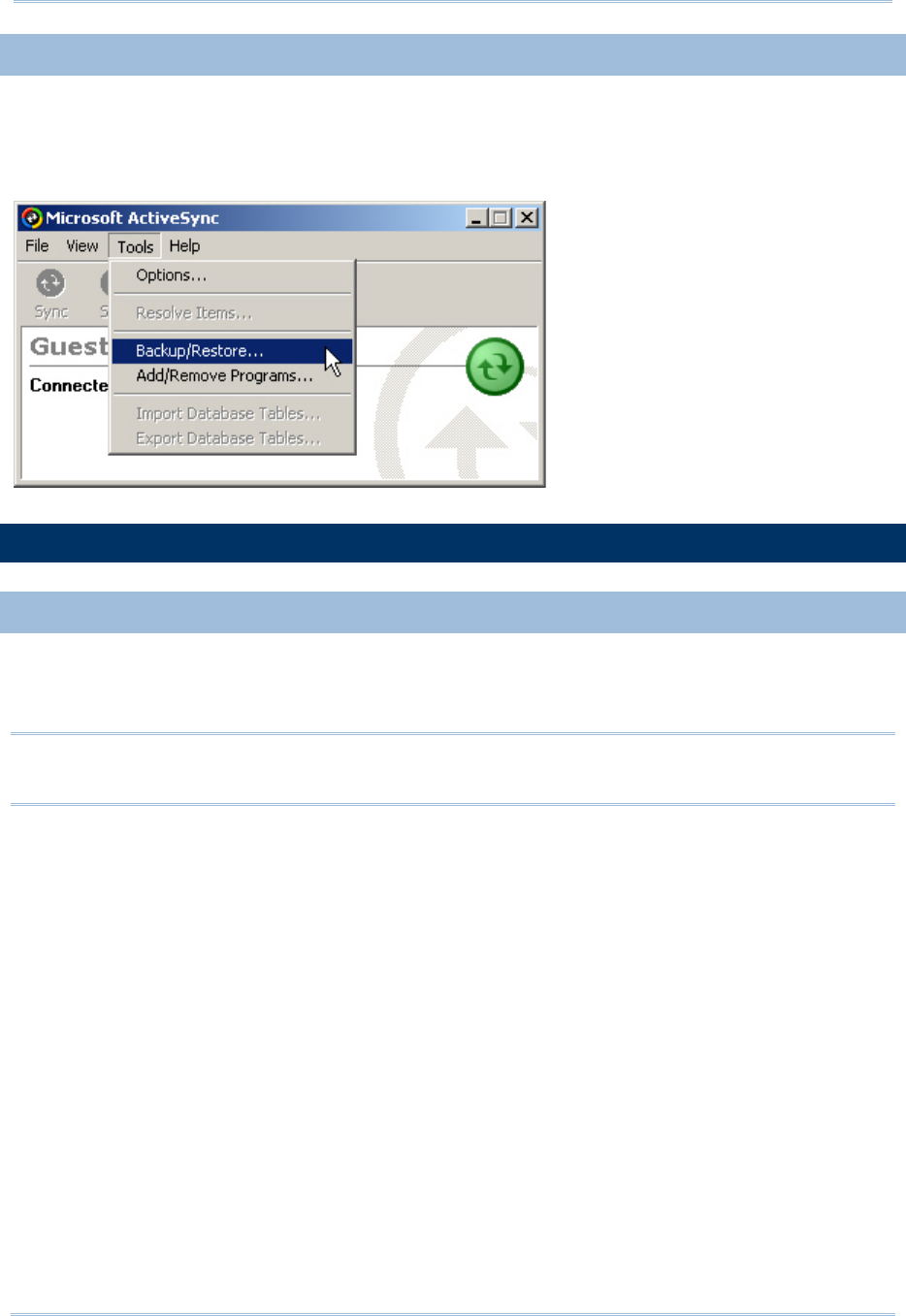
43
Chapter 2
2.3.3 BACKUP/RESTORE
To best protect your work, you should regularly back up information on your mobile
computer. You can perform a backup by during the ActiveSync operation. The
backup file is stored on your desktop computer.
2.4 MANAGING PROGRAMS
2.4.1 QUICK LAUNCH A PROGRAM
Tap the Start button to view the Start Menu. To quick launch a program, tap it from
the Programs folder.
Note: Alternatively, you may tap Start and select Run to run a specific program or
open a document.
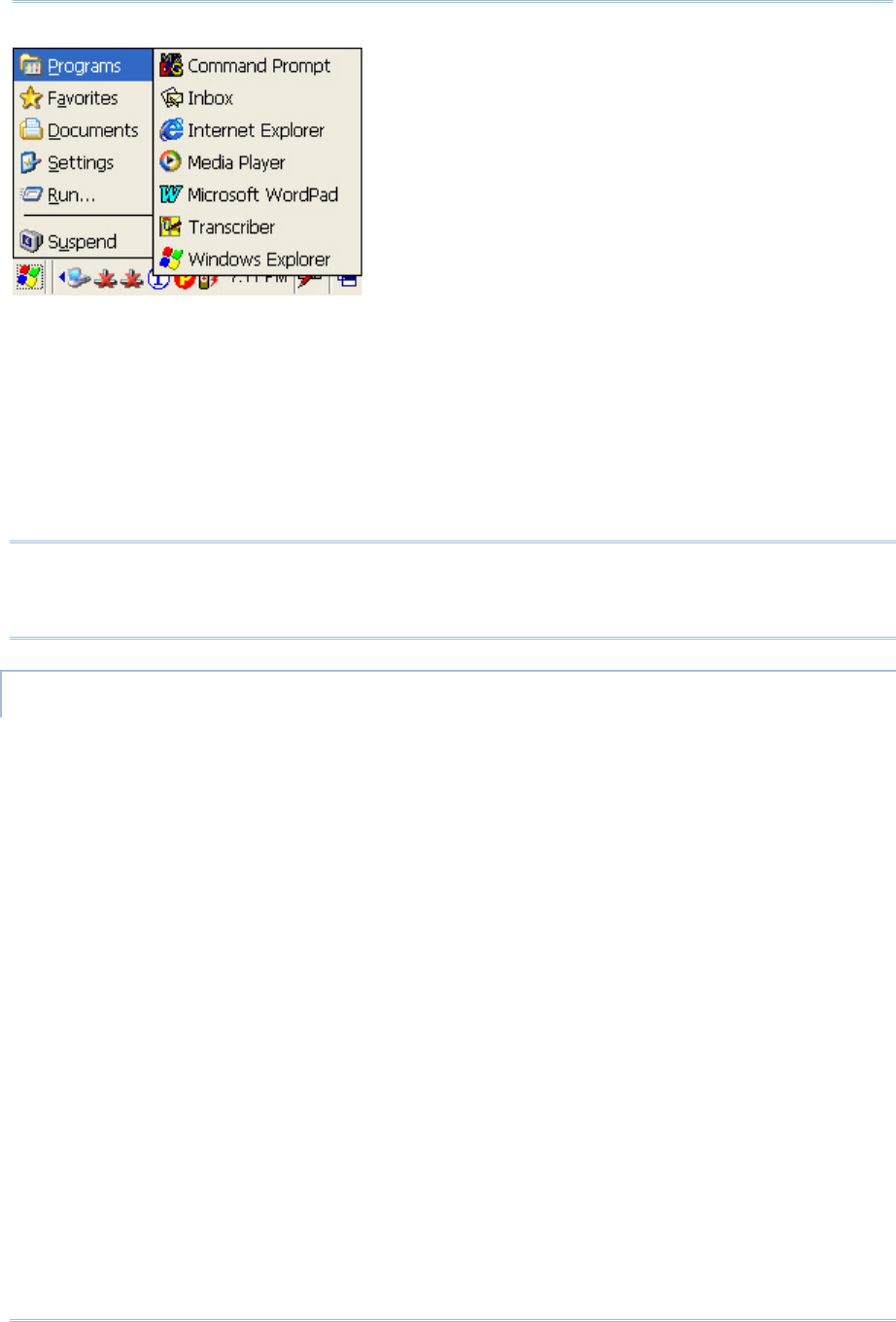
44
Terminal Reference Manual
If you wish to quick launch a new program, add it to the Programs folder: My
Device\Windows\Programs. The program will become available in the Start Menu.
To add a new program or subfolder to the Programs folder, you can either use
Windows Explorer or ActiveSync.
Windows Explorer: to move the program by [Copy] and [Paste Shortcut].
ActiveSync on the desktop computer: to create a shortcut to the program, and
place the shortcut in the Programs folder.
Warning: To avoid making any changes to the program configurations by
accident, we recommend you to use [Copy] and [Paste Shortcut]
rather than [Cut] and [Paste].
USING WINDOWS EXPLORER TO ADD A PROGRAM TO START MENU
1) Go to Start > Programs and select Windows Explorer.
2) Navigate through file folders to find the program you desire.
3) Tap and hold the program to select [Copy] from the pop-up menu (left below).
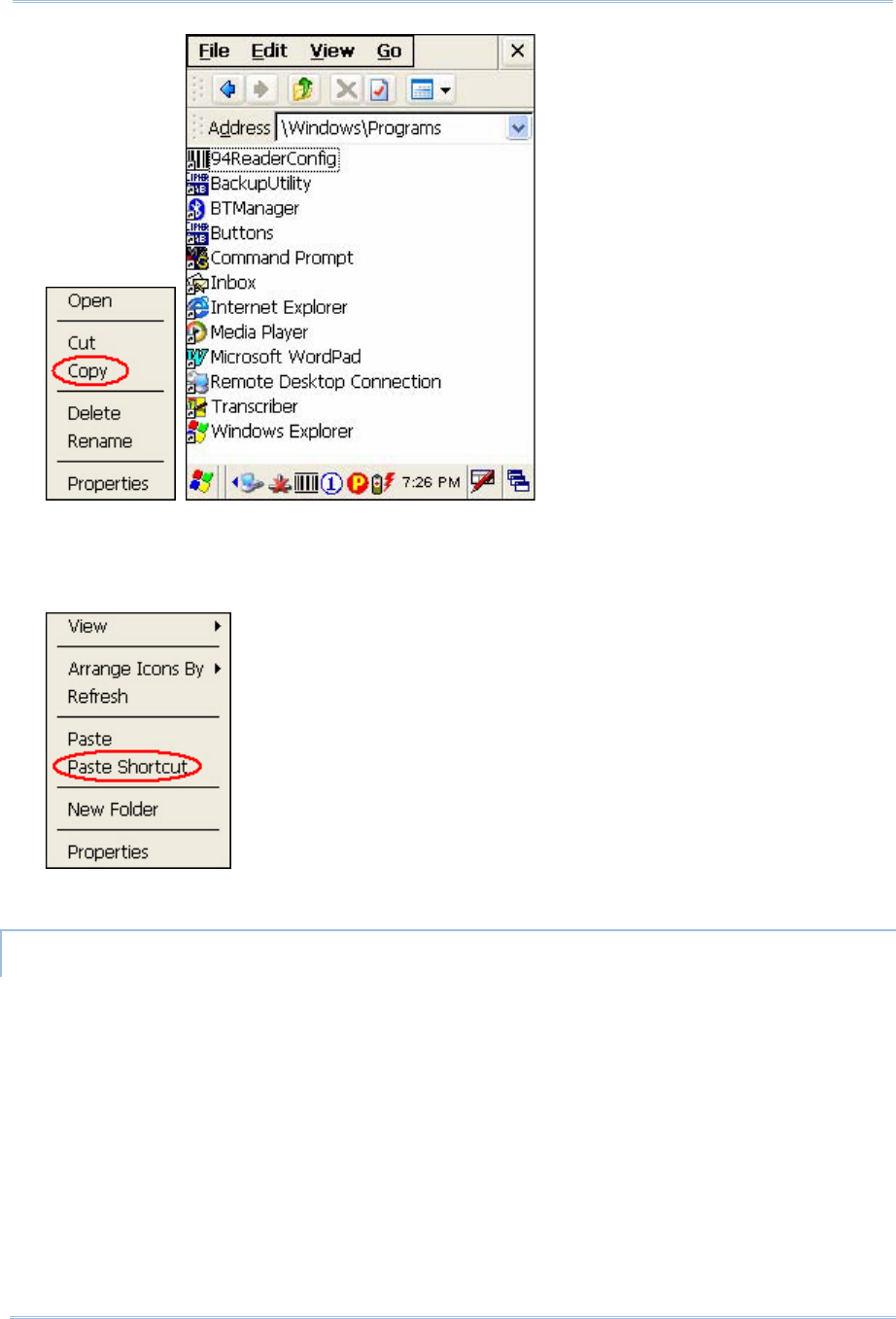
45
Chapter 2
4) Navigate to the Programs folder – My Device\Windows\Programs (right above).
5) Tap and hold anywhere blank on the screen to select [Paste Shortcut] from the
pop-up menu. The new program will be added to the Programs folder.
6) Go to Start > Programs and the new program will appear now.
USING ACTIVESYNC TO ADD A PROGRAM TO START MENU
1) When connected, open the Microsoft ActiveSync window on your desktop
computer.
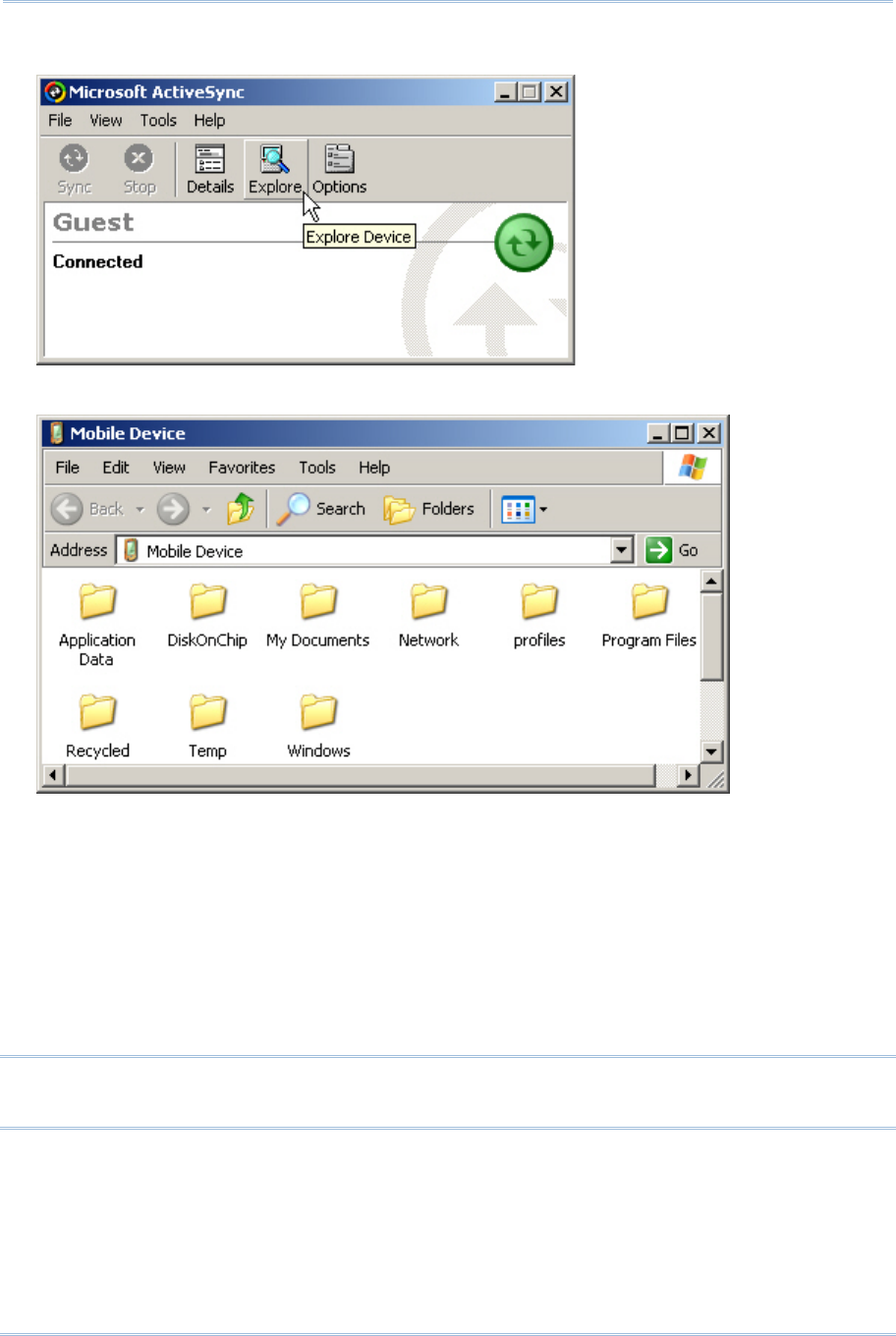
46
Terminal Reference Manual
2) Click the Explorer button from the toolbar.
3) Navigate through file folders to find the program you desire.
4) Right-click the program and select [Create Shortcut] from the pop-up menu.
5) Right-click the shortcut and select [Cut] from the pop-up menu.
6) Navigate to the Programs folder – My Device\Windows\Programs.
7) Right-click anywhere blank on the window and select [Paste] from the pop-up
menu. The new program will be added to the Programs folder.
8) On the mobile computer, go to Start > Programs and the new program will
appear now.
Note: [Create Shortcut], [Cut], and [Paste]: The same result can be performed by
[Copy] and [Paste Shortcut].
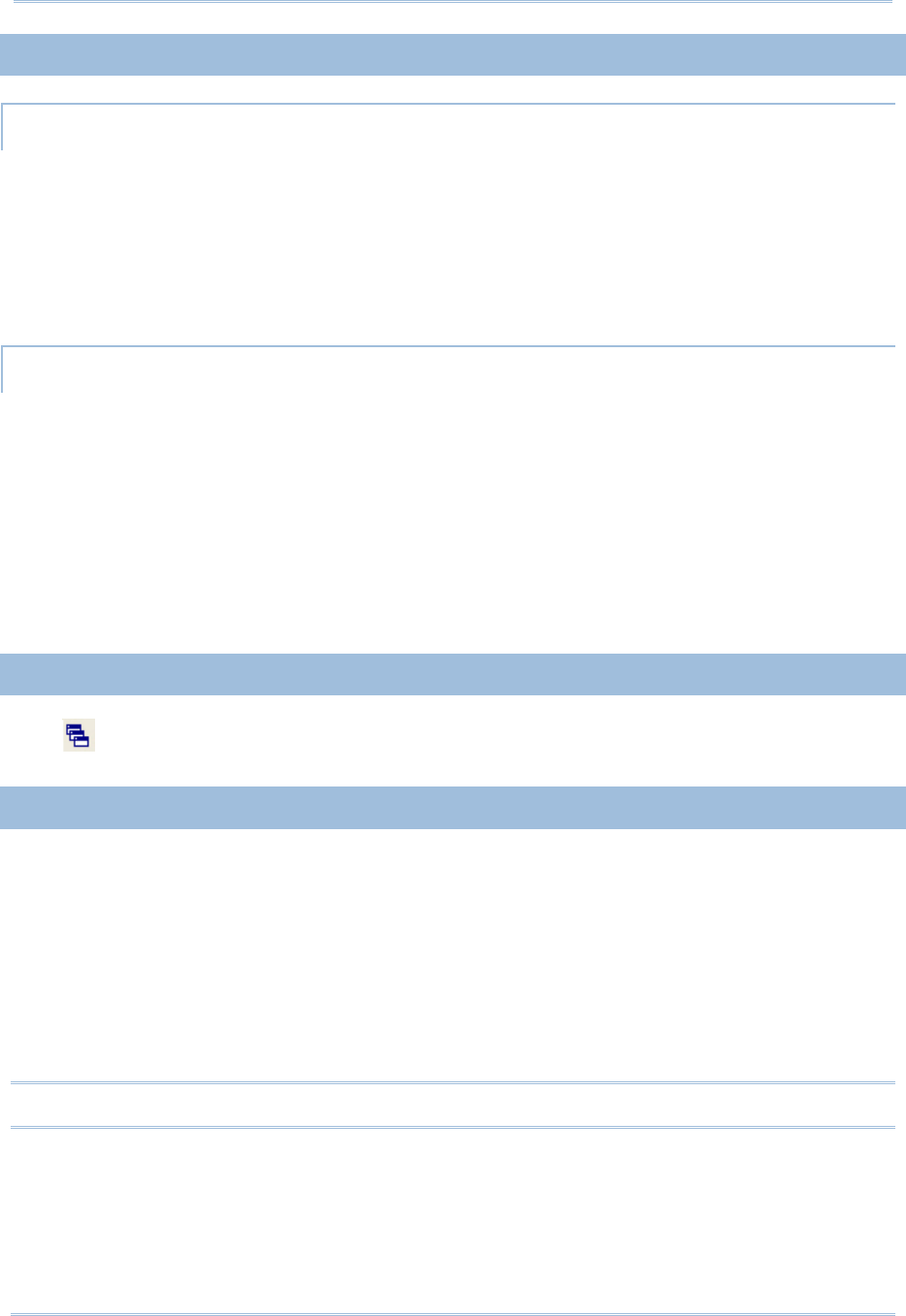
47
Chapter 2
2.4.2 CREATE A FOLDER
USING WINDOWS EXPLORER TO ADD A NEW FOLDER
1) Go to Start > Programs and select Windows Explorer.
2) Navigate through file folders to find where you wish to create a new folder.
3) Right-click anywhere blank on the window and select [New Folder] from the
pop-up menu.
A subfolder will be created.
USING ACTIVESYNC TO ADD A NEW FOLDER
1) When connected, open the Microsoft ActiveSync window on your desktop
computer.
2) Click the Explorer button from the toolbar.
3) Navigate to the target folder where you wish to create a new folder.
4) Right-click anywhere blank on the window and select [New Folder] from the
pop-up menu.
A subfolder will be created.
2.4.3 SWITCH AMONG PROGRAMS AND DESKTOP
Tap to the right of the taskbar and select a running program.
2.4.4 EXIT A PROGRAM
In general, the system manages memory automatically, and there is no need to exit
a program in order to open another or to conserve memory. However, random
access memory (SDRAM) may be used up when running too many programs. As a
result, it will slow down the operation or cause program errors. In that case, you
should stop one or more running programs to free memory.
In order to use memory in a more efficient way, you are recommended to exit a
program when it is not desired any longer.
Warning: Always remember to save data or settings before you exit a program.